&


OCTOBER 2023 FREE
Pushing back the ban of petrol, diesel cars plus gas and oil boilers!
+ Reaction to the Governments watering down on Net Zero pledges


+ This is the LANZADOR LAMBORGHINI GOES ELECTRIC :

NEWS • REVIEWS • INTERVIEWS • ELECTRIC CARS • SOLAR • RENEWABLE ENERGY
Enjoy fast, rapid or ultra-rapid charging on 98% of our network.


Whether it’s local deliveries or long-range journeys, we’re here to keep your drivers and your business powered up for the road ahead.
Allstar One Electric. Got yours yet?
Allstar One Electric




MONTH/YEAR DATE one electric
EDITOR’S NOTE
Every cloud, ey?
Oh dear. Where shall we start then? It had been quite a nice month until the news filtered through that our Prime Minister Rishi Sunak was going to take the completely mindless backwards step of delaying the 2030 ban on new petrol and diesel car sales.
It was a decision that was called out immediately, not just from the EV industry but from journalists, politicians and even fellow Tory MP’s. Even Ford, one of the world’s largest automakers which still retains a vested interest in internal combustion engine vehicles, called the move out. It is simply wrong.
Yet the whole ordeal had a sense of inevitability around it. Personally, I thought this day would come at some point; I never believed this government was as committed to electric vehicles as it said it was. Despite the predictability, the news still hurt and it was a kick in the teeth for everyone in the industry.
We have dedicated all three of our ‘EV News’ pages to this story, most of which is the reaction from everyone involved with electric vehicles. That, for me, has been the silver lining. Just like the Rowan Atkinson story, and all the other lies and misinformation that have been spread about EVs for the past however-long, the EV army came out in full force.

It was a shameful day for the UK when Rishi announced this, but we will never curl up into a ball and cry about it in a dark room. We did what we do best. Stand up, shout louder and make everyone know that this decision is stupid and reeks of corruption.
It is fitting that our interview feature this month is with Quentin Wilson, the founder of FairCharge. The topic of this conversation was centered around misinformation in the EV industry and where all the lies and negative press stems from, which Quentin says is driven by the fossil-fuel industry – That feels pretty

apt now considering Sunak’s announcement. You can read the full interview on page 8 and be sure to scan the QR code on the page to listen to the episode of The Everything EV Podcast with Quentin.
It’s not all doom and gloom, however. Elsewhere in the issue we have a special feature that looks at the Lanzador, Lamborghini’s vision for its first fully-electric vehicle. Jaws were well and truly dropped when Lamborghini pulled the covers off the this highly anticipated EV, so head on over to page 20 for our four-page special!
Electric motorsport continues to grow, and we have a new championship to talk about. E1 is a brand-new electric raceboat competition which has already assembled a star-studded list of owners. Never heard of it? Well, we’ve got you covered, so just head over to page 18 to find out everything you need to know about it. As always, we have our Formula E and Extreme E coverage which you can find from page 11, too.
Our Top Ten feature this month breaks down the ten best small electric SUVs, and there are a few more eye-catching electric vehicles in our ‘What’s New?’ spread on page 26. We also have an E-Bike review, columns and EV research inside, as well as all your Electric Home content, too.
Alvin
Business Development Director





Stephen Banks
Chief Creative Director
Stuart Hyde
Finance Director
Andrew Martin
3 TURNING ELECTRIC MAGAZINE
Thank you for your continued support and enjoy the read! Charlie Atkinson Editor, Turning Electric The Turning Electric Team Editor Charlie Atkinson Associate Editor Cherry Martin Graphic Designer Grace Moseley Videographer Jacob Pinchbeck Content Sales Manager Laura Phillips Capital Business Media, Group MD Richard
Turning Electric is published in London by © EV Powered Ltd a Capital Business Media group brand. Turning Electric is printed using sustainable paper sources and vegetable ink, and is PEFC certified. Copies are recycled at the end of each month. Capital Business Media Ltd, Level 18, 40th Floor, London, E14 5NR. Tel: 020 7148 3861




Contents 5 8 Let’s Make The EV Debate A Fair Fight! An interview with Quentin Wilson, founder of FairCharge. 12 The Formula-E Merry-Go-Round! The transfer window is open and we have the full breakdown. 14 ACCIONA | SAINZ XE Extreme E returned this weekend with the Island X Prix. 16 Extreme E and FIA Announce... ...plans for first-ever off-road hydrogen racing series. 18 An-E1 For An Electric Boat Competition?! A race backed by a star-studded list of owners! EV News The latest from the EV industry. 26 20 This is the LANZADOR Lamborghini goes electric and here is all you need to know! 18 20 24 Marin Ridt Zone E2 Electric Mountain Bike review by Richard Alvin. 26 What’s New? A monthly round-up of all the latest releases and upcoming EVs. 28 Top Ten Small EVs This month’s feature looks at the ten best small electric vehicles! 34 EVs Could Save Couriers £5.5k Per Year... ...with those working in clean air zones. 35 Is Misinformation Putting Brakes on EVs? Jordan Brompton of myenergi explores the latest. 38 Electric Home News The latest news and updates for everything Electric Home. 41 Smart Home: What Does It Really Mean? Learn more about what it takes to have a smart home. 42 Best Air Source Heat Pumps For Residental Homes in the UK. 44 Carbon Capture in the UK A Green Solution? 14 TURNING ELECTRIC MAGAZINE 4 46 Turning Over a New Leaf Your Guide to Sustainable Autumn Fashion. 48 Winter is Coming Small steps to big energy savings for UK homeowners. 50 Turning Green The present and future prospects of renewable energy.
SUNAK BACKTRACKS:
PM pushes petrol and diesel car ban back to 2035 strategy!
Prime Minister Rishi Sunak has delayed the 2030 ban on the sale of new petrol and diesel vehicles by five years as part of a wider relaxation of Net Zero policies.

In his announcement, Sunak said he was bringing Britain’s policies in line with the likes of Germany, France and parts of the US.
Sunak said: “I’m announcing today that we’re going to ease the transition to electric vehicles. You’ll still be able to buy petrol and diesel cars and vans until 2035. Even after that, you’ll still be able to buy and sell them second-hand. “We’re aligning our approach with countries like Germany, France, Spain, Italy, Australia, Canada, Sweden, and US states such as California, New York and Massachusetts and still ahead of the rest of America and other countries like New Zealand.”
Despite the U-turn, Sunak insisted the UK remains on course to reach Net Zero by 2050: “This country is proud to be a world leader in reaching Net Zero by 2050. There will be resistance, and we will meet it. Because I am determined to change our country and build a better future for our children. Nothing less is acceptable.”
Back in July, Sunak had reaffirmed his commitment to the 2030 ban on the sale of new petrol and diesel vehicles, however just days before the announcement, the Prime Minister hinted at pushing that date back, stating: “The 2030 ban itself is out of step with our competitor countries like the US and EU, who have kicked this back to 2035.” Cabinet minister Michael
Gove had insisted the 2030 ban on new petrol and diesel car sales was an immovable deadline however, in response to Sunak’s comments.
The government has also continued to back the development of the UK electric vehicle industry over recent weeks, with £75m of government funding going towards BMW’s new electric Mini plant in Oxford, as part of a wider £600m investment.
The proposed move has been heavily criticised, with several Tory MP’s criticising Sunak’s decision. Tory former Cabinet minister Sir Simon Clarke tweeted: “it is in our environmental, economic, moral and (yes) political interests as @Conservatives to make sure we lead on this issue rather than disown it.”
Car giant Ford also hit back at the reported plans. Lisa Brankin, Ford UK chair, said: “This is the biggest industry transformation in over a century and the UK 2030 target is a vital catalyst to accelerate Ford into a cleaner future. Our business needs three things from the UK government: ambition, commitment and consistency. A relaxation of 2030 would undermine all three. We need the policy focus trained on bolstering the EV market in the short term and supporting consumers while headwinds are strong: infrastructure remains immature, tariffs loom and cost-of-living is high.”
5 EV NEWS
INDUSTRY REACTION:
Outrage
as Sunak ditches 2030 ban!
Turning Electric spoke to a number of voices within the electric vehicle industry to get their reaction to Sunak’s decision to delay the 2030 ban on the sale of new petrol and diesel cars.

Jordan Brompton Co-Founder and CMO of myenergi:
“The postponement of the UK’s 2030 date for phasing out new petrol and diesel car and van sales – which of course has always permitted some forms of hybrids to continue to be sold – is not good news for anyone. It weakens confidence in UK investment. Vehicle manufacturers don’t like it. Those of us who are working to decarbonise homes and transport don’t like it. And families that cannot afford a new car won’t like it, because they may have to wait even longer to buy a cleaner and cheaper-to-run electric car in the used market.”

EV NEWS 6
Melanie Shufflebotham COO and Co-Founder of Zapmap:

“The Government should be looking to the future, not the past, so delaying the petrol and diesel ban would be foolish and irresponsible. The climate emergency is already here but Ministers continually fail to recognise the urgency of the situation.
“The growing popularity of electric vehicles shows that drivers are keen to play their part
in the transition to cleaner transport, which is a critical part of our journey towards net zero. A delay increases the risk that we’ll miss those targets. The number of public charging points is rapidly expanding – we’re approaching the 50,000 mark, with growth of more than 40 per cent in the last year alone – so the direction of travel is clear. The government must stick to its promises and start thinking long-term rather than short-term.”
Joel Teague Founder of Co-Charger:
“With regard to the underlying causes of these changes, I think Al Gore already said it best: “fossil fuel companies are better at capturing politicians than they are emissions.” The British people didn’t want these policies watered down. Neither did the energy industry or the automotive industry. If you follow the personal finances of those involved, and of party ‘donations’ you’ll quickly find the only group that wanted this. This is a dying industry using its puppet politicians to take what they can on the way out. Literally a ‘scorched earth’ strategy.
Kate Tyrrell CEO & Co-Founder EV ChargeSafe:

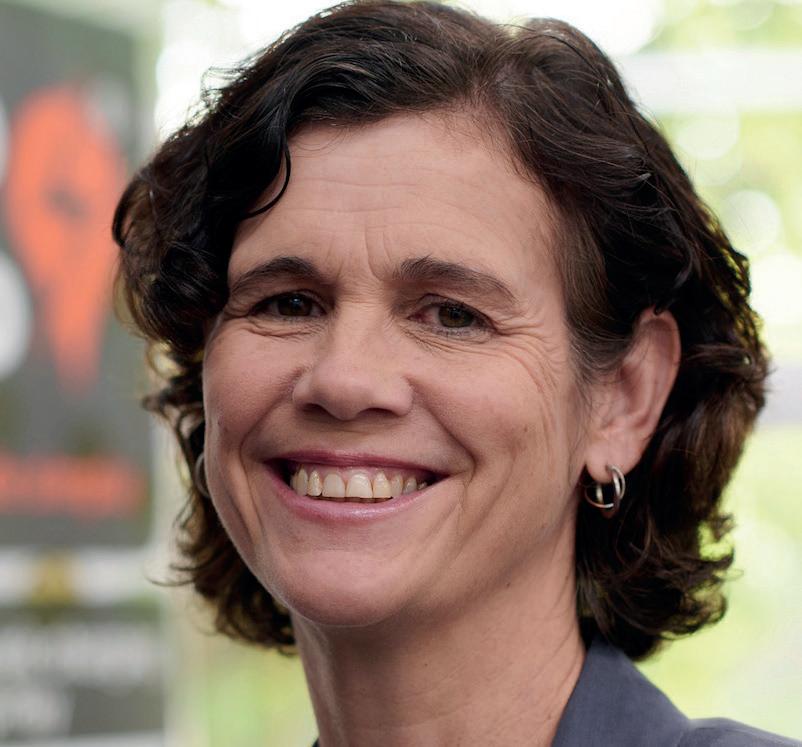
“Sunak delaying any of the industry’s advancement to independently drive the electric transition is unhelpful, disappointing and sadly not surprising. We have seen reports that Sunak’s family personally benefits financially from oil and gas money, and he is desperately scrambling to save blue seats ahead of the next general election, so this feels like a cheap shot at what I feel is the most important item on the agenda as we look to decarbonise transport.
“I’m sick of it and as a young entrepreneur trying to effect positive change for all motorists, I feel betrayed by this government and concerned for my business’ future, as well as the UK’s health and global climate targets as a direct result of what Sunak is toying with. The ban should stay, our air quality needs it, our children and grandchildren need it, an indecisive and corrupt government should be the ones to get ‘pushed back’.”
“However, the good news is that it will make no material difference. Sustainable solutions aren’t taking over at huge pace because of laws; they’re doing it because they are cheaper, cleaner and healthier. Better. Above all, they will succeed because they are all we can do to give us more time before the UK follows Greece, Hawaii, California, Australia, Libya, Pakistan, Ethiopia, Somalia, Kenya, China, France and countless others into climate change disasters for hundreds of thousands.”
Tom Hurst UK Country Manager at Fastned:

“Cleaner transport isn’t just important for meeting the existential threat posed by climate change, but more immediately poor air quality is costing lives today. From being at the vanguard of the EV revolution, the UK risks becoming a dumping ground for polluting vehicles from elsewhere.
“It’s especially puzzling given the fierce global race for green investment that the UK is already trying to compete in. Targets help secure investment, and as the UK lead of a European company with millions to invest in charging infrastructure it’s frustrating that in addition to byzantine planning rules and red tape for grid connections, there is now another hurdle in the way.”
7 EV NEWS
“
The British people didn’t want these policies watered down. Neither did the energy industry or the automotive industry. ”
“
I feel betrayed by this government and concerned for my business’ future, as well as the UK’s health and global climate targets as a direct result of what Sunak is toying with. ”
A FAIR FIGHT! EV
LET’S MAKE THE DEBATE
Quentin Willson, founder of FairCharge, joined The Everything EV Podcast to discuss the misinformation within the electric vehicle sector!
ing pumped in on a regular basis, is this just editor’s looking for clickbait in the sense that an EV story gets attention? Or is it something darker where fossil fuel advertisers are saying don’t promote electric cars?
Giles Coren did that celebrated piece on his Jaguar I-PACE in The Times, where he couldn’t get to work and he handed it back in to Jaguar. He told me that column got the most clicks of any column ever, and the editor said: “this is great!” so you get a snapshot of what we’re up against. It’s mischievous in the sense that if it is going to destabilize the energy transition, which I believe is so important for my kids, your kids and their kids, this is wrong, isn’t it? Who knows what the real reason is? But there is this tsunami of negativity which is affecting the way people think.


What is the mission of FairCharge?
It’s to increase the understanding and awareness of EVs, particularly among politicians. Our mission is to tell it like it is with factual accuracy because there’s so much out there that is against EVs. The fossil fuel industry has obviously spent quite a lot of money putting out all this misinformation and we see it on a regular basis, and it’s our job now to shoot this stuff down as soon as it appears.
The stuff you read routinely about bridges collapsing because of the weight of electric cars, electric cars causing potholes, we’re going to lose our front gardens because of electric cars because of the home charging etc. There was a survey the other day in The Mail that said real men don’t drive EVs, and you just think “where has this come from?” So that’s our job. We’re at the coalface every day shooting this stuff down. The problem is people are reading this in the mainstream media and it’s putting them off adoption. Even people who are thinking of buying Tesla’s say, “is it as bad as I’ve been reading?” So we will be talking quite clearly about all these myths and it’s politicians we need to talk to as well.
Is misinformation the biggest issue facing the industry at the moment?
If you look at the amount of coverage in newspapers, sometimes you get five anti-EV stories in a day on a single newspaper website. I’m not a conspiracy theorist, but with that amount of negativity be-
All the surveys we look at say that the satisfaction of having an EV is about 80 to 90%. Only 8% say they would go back to a combustion car, so you’ve got 92% saying we’re going to stick with our EVs and we don’t hear those voices. They just quietly get on with their life. It’s important to say right now that electric cars aren’t for everybody, and there will be this group of people who will never, ever drive them or buy them, and that’s fine. You can buy a combustion car up until 2030, or a hybrid right up until 2035. So the hysteria that is this cliff edge is not the apocalypse that the press would have us believe.

If you can get these people behind the wheel of an electric car, the experience is often so much better than they expected and it makes them see electric vehicles in a different light, doesn’t it?
We did a little thing on FairCharge Twitter and said when was the moment you decided you wanted to have an electric car in your life? And they said the minute I drove one. And this is the great irony, that we are being lectured by people who have never driven an electric car. I would say to anybody listening who hasn’t got an EV, just drive one and your life will change. I remember when I met Elon Musk in 2004, I had a long chat to him when he was launching the Tesla Roadster and he was starry-eyed and he explained this vision of electric cars that would go for 350 miles and he’d build this charging system which was going to be almost as easy as filling up with gas.
FAIRCHARGE 8 INTERVIEW AN


9 FAIRCHARGE INTERVIEW AN
” “
The fossil fuel industry has obviously spent quite a lot of money putting out all this misinformation and we see it on a regular basis, and it’s our job now to shoot this stuff down as soon as it appears.
And then this guy in a Ferrari 308 GTV draws next to me and rolls his window down and says “what’s that?” I said, “it’s a Tesla, race you,” and I absolutely smoked him. ”
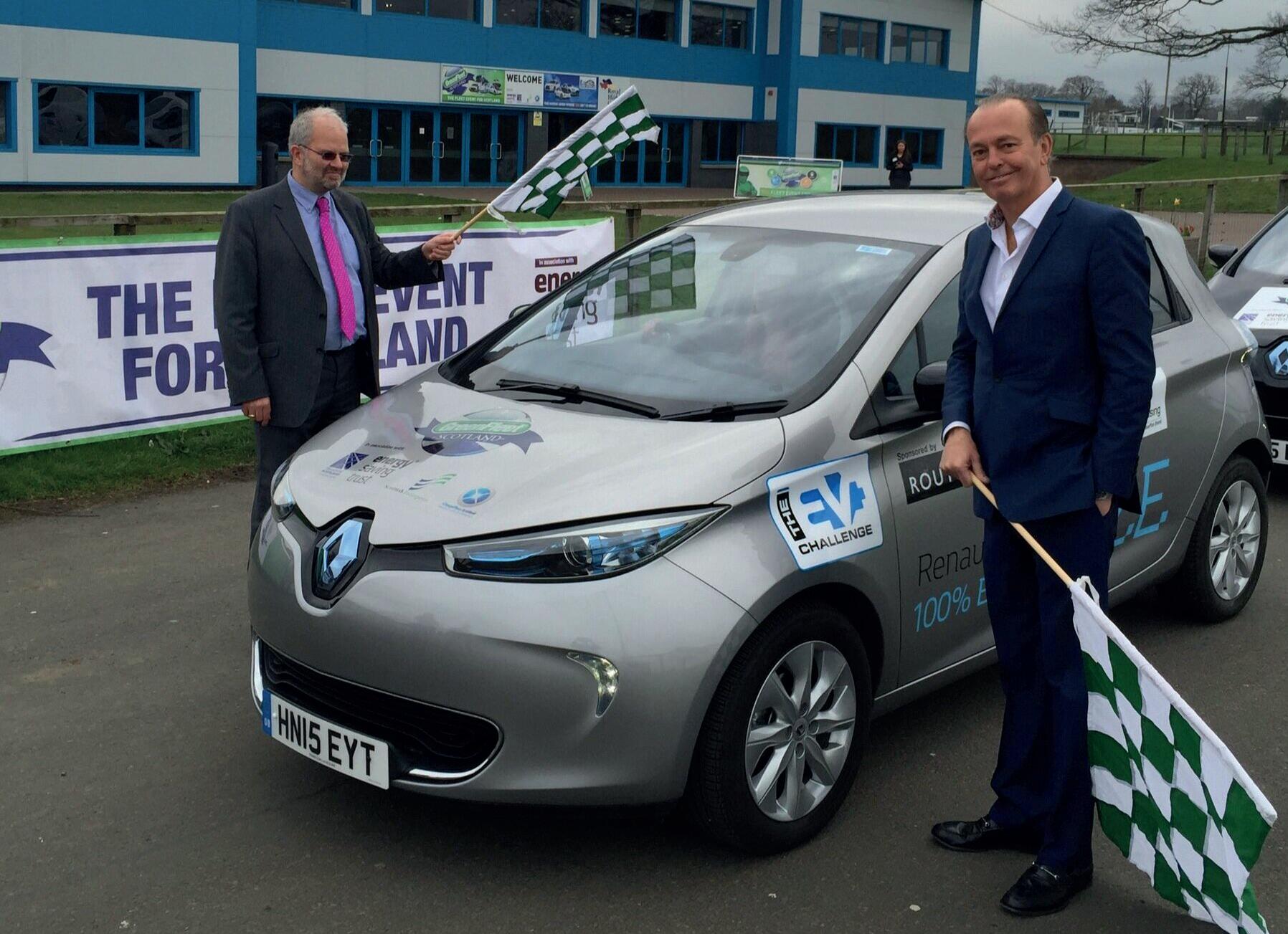

FAIRCHARGE 10 INTERVIEW AN
“
Then he gave me the keys to this Tesla Roadster, and I was still quite cynical because it was a Lotus Elise reworked, but I took it out on the M4, I’m just going “whoa, this is amazing!” And then this guy in a Ferrari 308 GTV draws next to me and rolls his window down and says “what’s that?” I said, “it’s a Tesla, race you,” and I absolutely smoked him. So it’s at that moment which you will, I guarantee, never ever forget in your life. You just go “if this is the future, I want it!”

A silver lining of all the anti-EV articles, such as Rowan Atkinson’s, has been the reaction from people within the EV industry, hasn’t it?

I remember that weekend very clearly because I switched on my phone and there it was. Rowan is a respected automotive figure but so much of that was wrong. I was spitting out my cornflakes! My PR director and I got onto The Guardian and said this is Tosh. We got other people to come in and printed a fact check piece after it and said there’s a lot of this that is wrong.
It was largely derided by lots of people, but it’s like you get a handful of feathers and you blow them. They go all over the place, and you can never ever get them back. That’s what that piece did. And the thing with digital media is it’s there forever; If you put in ‘are electric cars any good?’ this is all the stuff that comes up. All of us who have been on this journey understand how good these things are. We almost have a duty to make sure that we, as the people who have been on this journey, tell other people.
What does the landscape of electric vehicles look like to you?

I think it very much depends on government policy. We managed to get Sunak to pledge that 2030 was immovable and that they wouldn’t tinker too much with the ZEV mandate apart from just fine details. Now there’s a coven of right-wing backbench MPs who don’t like this and who are doing their best to completely destabilize it. We must make sure that they don’t go down this road where they could roll back 2030 because that means all the car manufacturers would really be in deep trouble. That’s a clear and present danger.
I think what we are seeing is better EVs coming onto the market, longer ranges, more interesting designs, whereas your choice was always quite limited. Now you can get everything.
But the biggest threat to it is misinformation. If we’re allowed to just carry on the way we’re doing, and it’s not towed out to sea and sunk by gunfire by vested interests, then we will see 50% penetration of EVs reasonably quickly in the next three or four years. We are seeing this penetration and what we also need to talk about is the advantages of buying EVs used because the prices are much, much, much lower and in some cases lower than the combustion equivalent. That’s a conversation that really isn’t being had at the moment. We need to understand that people need to be able to buy these things because at FairCharge we’re always saying this is about electrification that’s accessible. We’ve had these early adopters, these pioneers who approved the technology and they are usually middle class. Now we need to make it more accessible to people in
lower demographics because they have as much right to clean air, in fact more of a right than everybody else, because often they live in areas where the air isn’t good. That’s something that I think is really important to make EVs accessible to all.
What would you say to an ‘old-school’ petrolhead in order to convert them to EVs?
Well, there are two things: I’m an old school petrol head! I spent all my broadcasting career telling people to buy Jensen Interceptors and Maserati Ghibli’s and Ferrari Daytona’s. I’ve come from the dark side, if you like, and I’ve still got a V8 Mustang 1964. But the one piece of advice I would give is that if you doubt all this, then talk to somebody who owns an electric car.
Don’t read the stuff in the tabloids and actually the broadsheets as well. Talk to somebody who’s owned an EV, and they will tell you what it’s like without fear or favour. That’s really the only way to get information, isn’t it? We know that social media is not an exact science, and the stuff we read is often tosh. Talk to someone who’s owned, driven and likes an EV. There are people out there who’ve had them for ten years and have done 300,000 miles. Those are the voices you need to connect with to be able to make a value judgment on whether EVs are for you or not.
Scan this QR code to listen to the full episode of The Everything EV Podcast with Quentin Willson!

11 FAIRCHARGE INTERVIEW AN
THE FORMULA-E MERRY-GO-ROUND!
Following the end of Season 9, the Formula E transfer window is open and we have a full breakdown of all the drivers’ that have changed teams ahead of the new season!

Robin Frijns makes Envision Racing return!
Robin Frijns will make his return to Envision Racing for Season 10 of the ABB FIA Formula E World Championship.

The Dutchman, twice a Formula E race winner, enjoyed a four-season spell with the team between Seasons 5 and 8. He spent Season 9 at ABT CUPRA, with the Spanish manufacturer’s first foray into the championship at the start of the GEN3 era and on ABT’s return to competition in the world’s top tier electric racing series.
“I’m really excited about getting started again with Envision Racing after a year away from the team, it really does feel like coming home,” said Frijns. “It will be great to be joining a championship-winning team. Envision Racing have been fighting at the top pretty much every season, and I can’t wait to get started. We have a great car, and the aim is to be competitive, which I am sure we will be, and I am driving to win the championship.”
Nick Cassidy signs for Jaguar TCS Racing for Season 10
Nick Cassidy has completed Jaguar TCS Racing’s driver line-up for Season 10, with the Kiwi replacing the outgoing Sam Bird.
The Formula E race winner and 2023 title challenger will join fellow New Zealander Mitch Evans, who has been with Jaguar since they joined the all-electric World Championship in 2016. The two Kiwis will arguably be one of the strongest driver lineups on the grid, with 15 wins, 37 podiums, 11 pole positions and 1076 championship points between them.
Cassidy joins Jaguar TCS Racing off the back of his most successful season to date, having finished the 2023 season runner-up in the Drivers’ World Championship, bringing the title fight to the final weekend of the season. He was also instrumental in winning the Teams’ World Championship with Envision Racing, driving a Jaguar I-TYPE 6.

On the move, Cassidy said: “I’m very excited to be joining the Jaguar TCS Racing team for the 2024 ABB FIA Formula E World Championship and I am looking forward to racing for a team like Jaguar that has such a successful motorsport history.
“This season has been my most successful to date, so I can’t wait to get behind the wheel of the Jaguar I-TYPE 6 and fight for points, podiums and wins. Looking forward to having Mitch as a teammate, we have known each other since we were kids and have raced against each other for years, so I’m proud that we will be racing together and hope to continue to put New Zealand on the map in motorsport.”
FORMULA E 12
Sam Bird joins NEOM McLaren
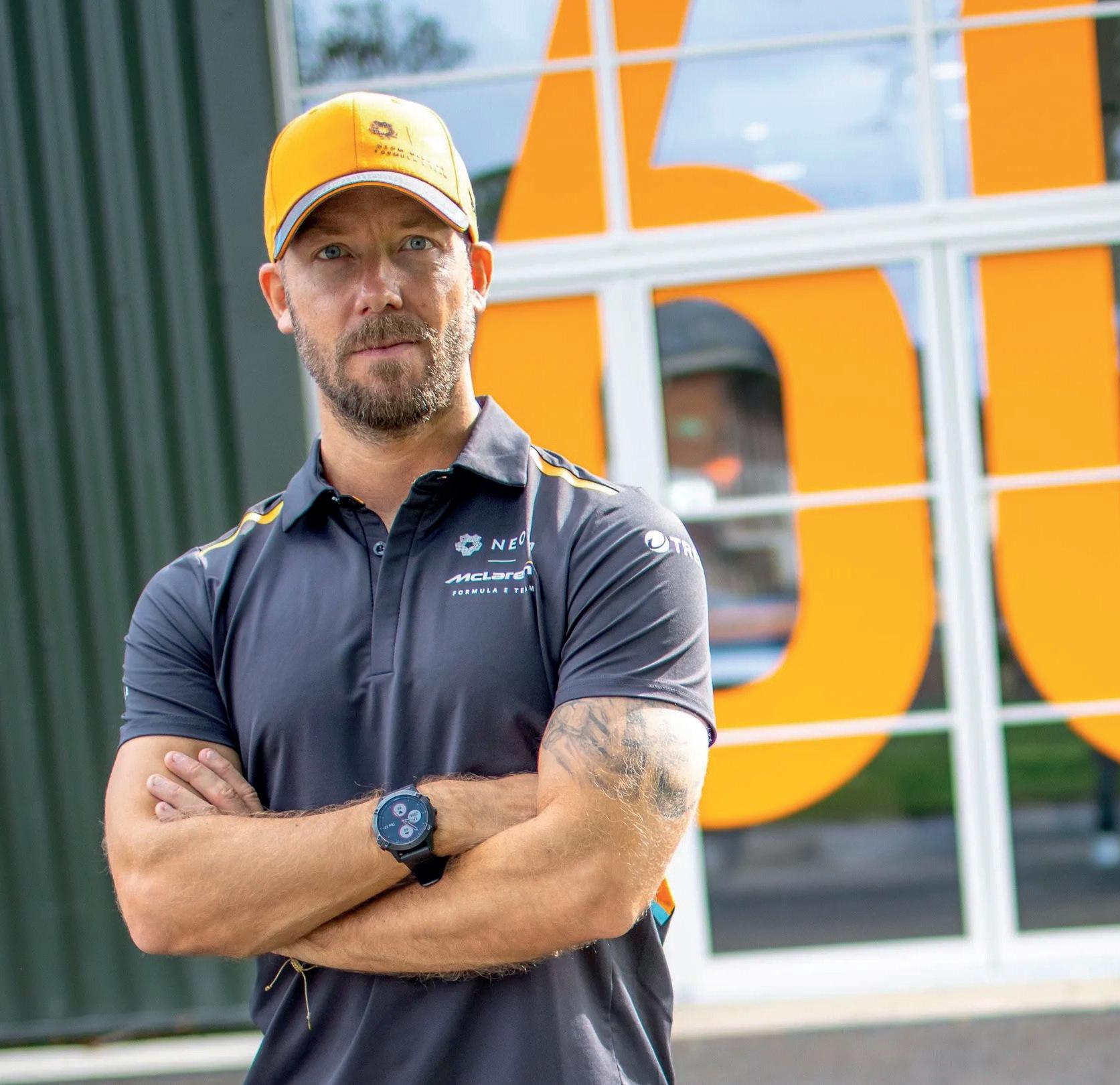

NEOM McLaren has announced that Sam Bird will line up for the team next season, competing alongside Jake Hughes.
Brit Bird has raced in Formula E since the very first campaign and Season 1. The 36-year-old is one of the most successful drivers on the grid, claiming 11 wins, 26 podium places and six Julius Baer Pole Positions over the course of those nine seasons. He left Jaguar TCS Racing after a three-season spell at the end of 2022/23, and says his move to McLaren – one of the most recognisable and successful names in motorsport history – is a “special” one.

“I’m super excited to get going with the NEOM McLaren Formula E Team,” says Bird. “Becoming part of a team with so much heritage and prestige as the McLaren Racing family feels special. We know there is some work to do ahead of Season 10, to ensure we get to where we want to be, which is at the front of the Formula E pack. It feels great to be part of the team and I can’t wait to kick off the season preparations, I’m super motivated and driven to deliver success with the team in Season 10.”
Rowland returns to Nissan Formula E Team for Season 10
Oliver Rowland will return to the Nissan Formula E Team to partner Sacha Fenestraz for Season 10 of the Formula E World Championship.
Rowland joined Nissan as a rookie in 2018, the same year the Japanese manufacturer debuted in Formula E. He raced for the team between Seasons 5 and 7, taking five pole positions and five podiums, including a victory in Berlin in 2020. The 31-year-old driver from Barnsley has a strong racing CV in addition to his Formula E success, taking the 2015 Formula Renault 3.5 Series title, along with a third-placed finish in the 2017 FIA Formula 2 championship. Meanwhile, Fenestraz will continue his development with the Nissan Formula E Team
after a promising Season 9. During his rookie year, the 24-year-old impressed many with his ability to adapt to Formula E machinery, claiming pole position and the fastest Formula E lap of all time at the Cape Town E-Prix in just his fifth race with the team. He also set the fastest lap of the race in Monaco and regularly fought at the front of the field.
Oliver Rowland, driver, Nissan Formula E Team: “I’m really excited, it’s a bit of a homecoming for me, back to the place I started my Formula E journey and somewhere I had a lot of success. The team has been on a great trajectory over the last year, with performances improving. I’m confident Sacha and I will make a strong pairing, he showed incredible speed in his first season. I’m looking forward to getting back to work, ready to go and can’t wait to see what we can do as a team.”
13
FORMULA E
Season 10 will be Formula E’s biggest of all time, with 17 races planned, including the first-ever E-Prix in Japan, set to be hosted in Tokyo on March 30, 2024. Pre-season testing will take place in Valencia on Oct. 23-27, before the opening round of the championship in Mexico City on Jan. 13, 2024.
ACCIONA SAINZ XE
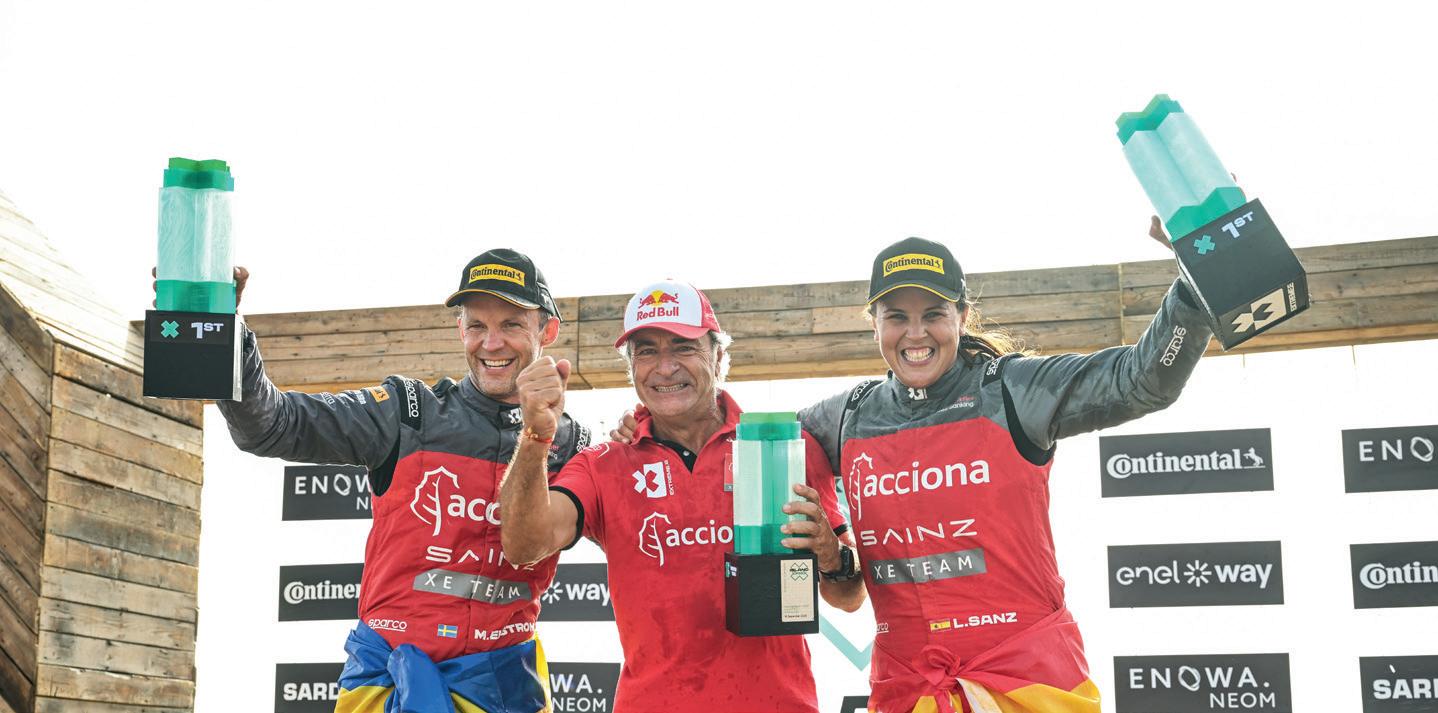
Extreme E returned this weekend with the Island X Prix and ACCIONA | SAINZ XE Team took control of the Championship with a dramatic victory in Round 7.
ROUND 7
Laia Sanz and Mattias Ekström took the win having dominated the day’s racing action with two Heat victories in Qualifying, and the Spanish team extends its lead to 18 points in the championship standings.
In a Grand Final that saw considerable to damage to four of the five cars competing, ABT CUPRA XE crawled across the line in second ahead of Veloce Racing, as the British squad struggled to find the finish line with broken wipers.
Rosberg X Racing (RXR), who had appeared out of contention when Johan Kristoffersson came to a stop on his opening stint, gained crucial championship points with fourth place despite broken power steering.
A DNF for Lia Block and Timo Scheider, having run in second place for most of the race, denied the pair their first podium together for Carl Cox Motorsport.

Winners of the Redemption Race and the Continental Traction Challenge were Timmy Hansen and Catie Munnings, as Andretti Altawkilat Extreme E ended the day on a high following a DNF in Qualifying 1 and a DNS in Qualifying 2.
Laia Sanz, ACCIONA | SAINZ XE Team, said: “Today was a perfect day, one of the best we have enjoyed so far in Extreme E. This doesn’t happen very often, because everything can happen in this Championship. Mattias made a massive start in the Final. Both of us did really well in the Qualifying heats. We did a good job. We are happy and today we will enjoy it, but at the same time, we are still focused on tomorrow. We want this Championship and we must keep fighting.”
Mattias Ekström, ACCIONA | SAINZ XE Team, said: “I think it was a really good day. We felt good yesterday in the dry and today with the watered track. We had a good set-up, good strategy, and two good Qualifying heats. I think the key to the race win was the first corner at the start. I made a move around the outside and went from P4 to P1, and after this, I had a clean windscreen and a beautiful, enjoyable few laps. I enjoyed it a lot. Laia made no mistakes, she was very clean. We did a really good job today.”
EXTREME E 14
ROUND 8
X44 Vida Carbon Racing took the win in Round 8, marking the team’s second victory of Season 3 and first victory at an Island X Prix.
Cristina Gutiérrez and Fraser McConnell took the win ahead of Rosberg X Racing (RXR) in second, who just missed out on taking the championship lead from ACCIONA | SAINZ XE Team, sitting just three points behind the Spanish outfit in the standings.

The third step on the podium went to ABT CUPRA XE, as Klara Andersson and Sébastien Loeb secured back-to-back podiums at this Island X Prix.

No.99 GMC HUMMER EV Chip Ganassi Racing took fourth, with RJ Anderson going wheel-towheel with RXR’s Johan Kristoffersson in an exciting bout. A DNF for JBXE in their second Grand Final dashed the team’s hopes of a first podium in Season 3, but matches their season best of fifth place.

Winners of the Redemption Race were Kevin Hansen and Molly Taylor, as Veloce Racing keep themselves within reach of the title as the championship battle reaches a thrilling climax. Just 21 points separate the top three as Extreme E heads into the last two rounds of Season 3, in Chile (December 2-3).
Cristina Gutiérrez, X44 Vida Carbon Racing, said: “We had a tough start to the weekend, but we kept our spirits up and with all the team working together we prepared well for the final. Fraser had an amazing start and I just had to keep my head focused to get us round for the win! We are so happy and proud of the team!”
Fraser McConnell, X44 Vida Carbon Racing, said: “So happy to redeem ourselves in Sardinia. Cristina and I had our heads down and drove four strong clean laps in the final. As always, the team worked tirelessly to make sure the car was in top shape. Big up to team X44 Vida Carbon Racing. This won’t be the last you hear from us!”
CHAMPIONSHIP STANDINGS
XE TEAM

15 EXTREME E
01 03 139PTS 118PTS ACCIONA | SAINZ
02 136PTS 04 99PTS 05 87PTS
VELOCE RACING NO.99 GMC HUMMER EV CHIP GANASSI RACING X44 VIDA CARBON RACING 06 08 75PTS 45PTS ABT CUPRA XE 07 71PTS 09 42PTS 10 40PTS ANDRETTI ALTAWKILAT EXTREME E NEOM MCLAREN EXTREME E TEAM JBXE CARL COX MOTORSPORT
ROSBERG X RACING
EXTREME E AND FIA ANNOUNCE PLANS FOR FIRST-EVER OFF-ROAD HYDROGEN RACING SERIES
EXTREME H, the newly branded hydrogenpowered off-road SUV championship, is set to commence from 2025.

The Fédération Internationale de l’Automobile (FIA) and Extreme E have signed a non-binding Memorandum of Understanding setting out a framework to create the first-ever hydrogen offroad racing world championship.
This document is the first step in establishing a pathway for the hydrogen series, Extreme H, to become an FIA Championship from its inaugural season in 2025, with the intention that it will become an FIA World Championship from 2026, should the requisite criteria be met.
In addition, the pathway outlines that in 2024 Extreme E, currently an FIA International Series, would be recognised as an FIA Championship.
Extreme H would join the company of just seven other official FIA World Championships, which includes ABB FIA Formula E World Championship. This planned pathway to FIA World Championship status demonstrates the series’ progression since its inception in 2021 and a strong statement of intent for its growth towards its hydrogen-powered future. Development of the Extreme H series is underway, with plans advanced to have a prototype launched later this year ahead of the first season in 2025.
Alejandro Agag, Founder and CEO of Extreme E, said: “Establishing alongside the FIA a world-first hydrogen racing world championship will be a momentous milestone for Extreme E and the new Extreme H series. Eventual accreditation as an FIA Championship and then an FIA World Championship means we would be amongst the top tier of global motorsport categories, and Extreme H would be the first-ever world championship racing series of its kind.

“What started as a conversation many years ago about racing in extreme environments, showcasing the incredible performance and innovation of E-SUVs, has now demonstrated enormous growth and further pioneering technical advances as we move forward with the transition to hydrogen and Extreme H – a world-first.
“This announcement is a significant first step in the development of our championship and our ground-breaking transition to hydrogen-powered racing. Sport is the most powerful and effective platform to drive innovation and our commitment to delivering sustainable motorsport championships full of excitement and with a reduced carbon footprint are testament to that.
“Once it achieves FIA World Championship status, Extreme H will continue what Extreme E started as a pioneering motorsport series and we look forward to delivering another spectacular sporting product. I’d like to thank the President and the FIA for their continued support and recognition of our ambition to create a world-first for motor racing. Expect to see yet more exciting racing out on course, as well as further pushing the boundaries of new technologies in the race to tackle climate issues.”
Mohammed Ben Sulayem, President of the Fédération Internationale de l’Automobile, said: “We are excited to continue working with Extreme E on their journey to becoming an FIA World Championship. Using sustainable power sources in motor sport is the key objective of the FIA and part of our long-term strategy, and this series is an ideal showcase for that. Hydrogen is an important part of that mix, and we have developed a set of safety regulations for hydrogen-powered vehicles which is part of the FIA’s International Sporting Code.
“It is encouraging that such a major motor sport entity as Extreme E with its renowned line-up of teams sees the same potential in hydrogen technology. Their approach to equality and diversity matches ours as we push to make motor sport accessible for all.
EXTREME E 16
EXTREME H FROM 2025 – AIMS TO MINIMISE ENVIRONMENTAL IMPACT WHILE MAXIMISING AWARENESS, ACING IN PLACES THAT HAVE ALREADY BEEN DAMAGED OR AFFECTED BY CLIMATE CHANGE OR HUMAN INTERFERENCE, AND TAKING FANS DEEP INTO THE HEART OF THE MOST PRESSING ISSUES FACING OUR PLANET’S FUTURE.


“Motor sport competition serves as an excellent research and development platform and this new series has great potential. Having the technology tested in the harsh environment of off-road racing in all types of conditions should benefit the whole industry, and in the longer term make mobility more environmentally friendly for everyday users of the road. We are looking forward to working with Extreme E, sharing our know-how and expertise.”
Extreme E boasts legendary motorsport names across its championship, from team owners Sir Lewis Hamilton, Nico Rosberg and Jenson Button to motorsport heavyweights McLaren, Andretti and Chip Ganassi – with world champions across multiple disciplines competing in the series since it launched just over two years ago.
The first sport to ever be built out of a social purpose, Extreme E – and Extreme H from 2025 – aims to minimise environmental impact while maximising awareness, racing in places that have already been damaged or affected by climate change or human interference, and taking fans deep into the heart of the most pressing issues facing our planet’s future.
17 EXTREME E
THE FIRST SPORT TO EVER BE BUILT OUT OF A SOCIAL PURPOSE, EXTREME E – AND
FOR AN AN-E1 ELECTRIC BOAT COMPETITION?!
E1 is an all-electric raceboat championship which has been backed by a starstudded list of owners, and this is everything you need to know about it.
1. A NEW ERA OF ELECTRIC RACING
E1 is the first electric raceboat championship sanctioned by the Union Internationale Motonautique (UIM), the world governing body of powerboating. E1 holds an exclusive license with the UIM to promote a racing series on the water powered solely by electric. The championship was established to create a new, competitive on-water racing proposition based on clean technologies to protect our waters and coastal areas.
2. A REVOLUTIONARY NEW RACEBOAT


Central in every category of racing is the vehicle, or in this case the vessel, which the competitors will race with. In the E1 World Championship, the pilots will fly above the water’s surface behind the wheel of the RaceBird using innovative hydrofoil technology. The boat is the brainchild of Norwegian designer Sophi Horne and was brought to life together with naval architect and marine engineer Brunello Acampora.
3. TRANSFORMING MARINE MOBILITY
E1’s philosophy has been inspired by the success of other forms of electric racing and how they act as a platform to accelerate sustainable technologies. Series co-founders Alejandro Agag and Rodi Basso aim to apply that same ethos to racing on the water and help decarbonise future leisure boats. Along with being a proving ground for electric technologies, E1 is also committed to making a positive impact beyond racing.
star-
4. ROTTERDAM PREVIEW
For the first time, E1 will be exhibiting multiple RaceBirds in front of huge crowds, launching separate eye-catching new liveries with gender-equal split pilot teams. The E1 Rotterdam Preview will take place at the 46th edition of the largest annual maritime event, World Port Days, in Rotterdam, Netherlands. Across 1-3 September, more than 100,000 visitors each day, will witness multiple RaceBirds taking to the waters of Rotterdam. Not only will the RaceBirds be running on the water at high speeds in front of the scenic Erasmus Bridge, E1 will debut multiple unique stunning liveries, each showcasing the colours of the championship.
5. HOLLYWOOD OWNERS
The brand-new E1 electric raceboat series has already claimed a star-studded list of owners, including world famous DJ Steve Aoki, tennis legend Rafa Nadal and former Chelsea striker Didier Drogba. One of the latest celebrities to sign up to E1 is one of the world’s most successful sports stars, Tom Brady. Through his new role as team owner in the UIM E1 World Championship, Brady is looking to inspire future generations towards innovation and action for a sustainable future.
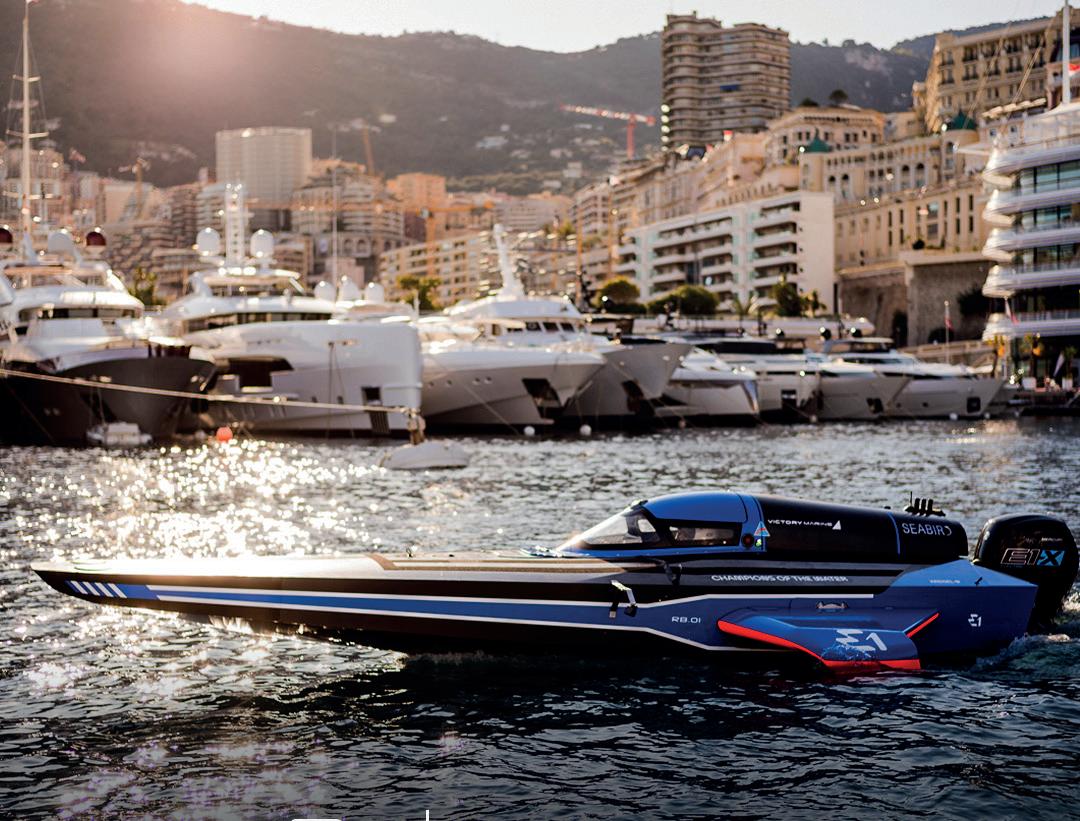


Alejandro Agag, Co-Founder and Chairman of UIM E1 World Championship, commented: It’s great to welcome Tom Brady to the UIM E1 World Championship. Tom is a winner and will bring his incredible spirit to our races. Alongside Rafael Nadal, Didier Drogba, Sergio Perez and other big names that we will announce soon, he will be fighting for victory at every race. To have a personality like Tom is a huge boost for the UIM E1 World Championship.”
7. E1 PILOT ACADEMY
With the UIM E1 World Championship getting underway in Jeddah, Saudi Arabia in early 2024 – and team announcements gathering pace – training a new generation of racing stars in the UIM E1 Pilot Academy is well underway. The search is on for male and female athletes with experience in motorsport, cycling, Esports, extreme sports and high-speed sports who want to test their mettle in the world’s first all-electric boat racing series.
The Academy is managed by Nina Dreier who has previously worked with esteemed companies like Red Bull, Formula E and Extreme E, providing an invaluable experience in the sports marketing and entertainment industry.
Along with expert tuition from other notable figures in the marine industry, candidates will undergo an advanced training course designed to test their racecraft skills at close quarters, in different vessels and in varying water conditions.The process will culminate in August and September across Saudi Arabia, Italy and the UK, before the final 20 pilots are revealed in October.

19 E1
COMPETITION?!
This is LANZADOR
Lamborghini goes ELECTRIC

is the LANZADOR
Lamborghini unveiled its brand new, fully-electric GT concept, the Lanzador, at Monterey Car Week back in August, and this is everything we know about it so far...

ELECTRIC:
As part of the brand’s Direzione Cor Tauri strategy, this concept marks a significant step towards the decarbonization and electrification announced in 2021.
With an innovative Gran Turismo 2+2 concept, the Lanzador is equipped with two electric motors, one for each axle, providing all-wheel drive and efficiency in all driving conditions, on all surfaces, and in every driving style. The system delivers a peak power that exceeds one megawatt and the car is expected to offer around 1,360hp.
The driver can independently adjust the control systems while on the road via controls on the sports steering wheel, actively modifying the car’s behavior and creating their own individual profile. The new version of the driving dynamics control system, Lamborghini Dinamica Veicolo Integrata (LDVI), will give drivers freedom of customization, allowing them to modulate the active control systems to best suit their driving needs.
Active Aerodynamics is another key feature of the Lanzador, employed in the front and rear to maximize aerodynamic efficiency in the different driving modes. This technology enables the car to regulate airflow precisely, increasing the range in Urban mode and increasing downforce in Performance mode.
Stephan Winkelmann, Chairman and CEO of Automobili Lamborghini, remarked: “With this concept, we are ushering in a new car segment, the Ultra GT, which is poised to offer customers a new and unparalleled driving experience, one that’s quintessentially Lamborghini, thanks to groundbreaking technologies.”
DESIGN
The Lanzador is technically an ultra-GT, SUV-crossover, with clear influences from other Lamborghini models like the Urus and Huracan.
Front on, the Lanzador takes on the traditional Lambo aesthetic, with razorthin LED headlights and the pointy nose. From the side, however, the Lanzador is unlike any other Lamborghini out there. It is a much more rugged than some of the other Lambo models we’ve seen, with the sharp, dramatic creases giving a very slight ‘Cybertruck’ vibe. In fact, the Lanzador does have certain design
LANZADOR A TRUE MILESTONE AS THE COMPANY CONTINUES ACTIVELY TO ELECTRIFY OF VEHICLES AND TO ACHIEVE DECARBONIZATION
elements which makes you think it will be able to hold its own off-road, with the thick black cladding around the wheel arches, the raised ride height and the 23-inch alloy wheels. Although, I doubt anyone that owns a Lanzador is going to want to take it through a puddle, let alone off-road.
The interior is a truly futuristic space, incorporating Lamborghini’s “Feel like a pilot” approach. The driver and passenger are accommodated in an ergonomic environment, with a light, slim control panel that makes it possible to actively modify the car’s behavior while driving. The sustainable materials used for the interior, such as merino wool and regenerated carbon fiber, demonstrate the company’s commitment to reducing its environmental impact without sacrificing the luxury and comfort typical of a Lamborghini. Some of the non-visible plastic elements, such as the foam in the sports seats, are made from 3D-printed recycled fibers.
PRICE & RELEASE DATE
The Lanzador remains a concept for now, although it does preview a futurelimited car run, which will be the brand’s first production electric vehicle, which is set to launch in 2028. In terms of price, details have yet to be confirmed, however some reports have stated that it will go for around £500,000!

Lanzador represents a true milestone for Lamborghini as the company continues actively working to electrify its entire range of vehicles and to achieve decarbonization. The new concept car is part of a broad strategy to reduce CO2 emissions and embrace a more sustainable vision for the future.


MILESTONE ACTIVELY WORKING





MARIN RIFT ZONE E2 ELECTRIC MOUNTAIN BIKE REVIEW
Recently, Richard Alvin had the opportunity to test the Marin Rift Zone E2 electric mountain bike, and I must say, it has left a lasting impression on me.

The Marin Rift Zone E2 is a really great bike, from its design and performance to its value for money. So, without further ado, let’s dive in.
INTRODUCTION
The Marin Rift Zone E2 is a versatile and fun eMTB designed for trail riders who demand a balance between power, performance, and efficiency. This bike is well-suited for a wide range of terrains and riding styles, thanks to its modern geometry, impressive suspension kinematics, and well-thought-out componentry. With its 140mm of travel, 29-inch wheels, and Shimano EP801 electric bike motor, the Rift Zone E2 promises to deliver an exciting and thrilling ride for both seasoned and novice mountain bikers.
DESIGN AND FRAME
The Marin Rift Zone E2 features a sleek and robust aluminum
frame with clean lines and smooth welds, giving it an attractive and sturdy appearance. The frame is equipped with Marin’s Series 4 hydroformed aluminum tubes, which provide excellent strength and durability. In addition to its robust construction, the Rift Zone E2 boasts a modern geometry that includes a 65-degree head tube angle, a steep 77-degree seat tube angle, and a long reach, ensuring a comfortable and efficient riding experience.
The bike’s internal cable routing gives it a clean and clutter-free look, while the bump stops on the underside of the down tube prevent the fork from causing any damage when turning. Furthermore, the Rift Zone E2 comes with chunky chainslap protection on the driveside chainstay and uses the SRAM Universal Derailleur Hanger, making it compatible with SRAM’s Eagle Transmission.
SUSPENSION AND MOTOR
The Marin Rift Zone E2 is equipped with a Fox 36 Performance Elite fork and Float X Performance Elite shock, offering 140mm of travel at both ends. This suspension setup allows the bike to tackle a variety of terrains with ease, providing a smooth and responsive ride. The MultiTrac suspension design used by Marin delivers a progressive leverage rate, making it well-suited for both air and coil shocks, as well as the extra weight of e-bikes.
The E2 is powered by Shimano’s latest EP801 motor, which offers a maximum power output of 600W and 85Nm of torque. This motor provides smooth and natural assistance, allowing you to tackle challenging climbs and maintain higher speeds with ease. The bike is also fitted with Shimano’s 630Wh BT-EN806 battery, which is only compatible with the newest generation of EP801 and EP600 motors. This powerful battery ensures a long-lasting and enjoyable ride, without any range anxiety or lack of power.
GEOMETRY
The Marin Rift Zone E2 boasts a modern geometry that places it firmly in the trail bike category. With a 65-degree head tube angle and a steep 77-degree seat tube angle, this bike offers a stable and comfortable

riding experience on both descents and climbs. The Rift Zone E2 is available in four sizes, from small to extra-large, with reach figures ranging from 445mm to 515mm. Low standover heights and short seat tube lengths ensure that riders of all sizes can find their perfect fit, while the bike’s wheelbase and chainstay lengths provide a balanced and agile ride. The bottom bracket height remains relatively low, giving you a centered and grounded feeling while riding.
SPECIFICATIONS AND COMPONENTS
The Marin Rift Zone E2 comes with a well-thought-out and functional component selection that enhances its overall performance on the trails. Key components include Shimano’s XT M8130 11-speed Linkglide drivetrain, SLX M7120 four-piston brakes, and Fox’s Performance Elite air-sprung 36 fork and Float X rear shock, which offer plenty of adjustment options.
Marin’s own-brand rims are wrapped in either Vee Tire or Maxxis rubber, providing excellent grip and traction on various surfaces. Additionally, the Rift Zone E1 and E2 models come with CushCore inserts and Marin’s latex-free tubeless sealant as standard, ensuring a puncture-free and reliable ride.
The cockpit is adorned with Marin’s Trail Bar, CNC stem, Grizzly lock-on grip, and Marin saddle, providing a comfortable and ergonomic riding experience. The TranzX dropper post offers 170mm of travel, ensuring quick and easy saddle adjustments on the go.

RIDE IMPRESSIONS
During my test ride on the Marin Rift Zone E2, I was incredibly impressed with its performance across a range of terrains and conditions. The bike’s modern geometry and suspension setup provided a comfortable and stable ride, allowing me to tackle both smooth and technical trails with confidence.
CLIMBING PERFORMANCE
The Rift Zone E2’s geometry, combined with the powerful EP801 motor, made climbing a breeze. The bike’s supportive suspension ensured excellent traction and control on steep and challenging climbs, while the Shimano motor provided smooth and consistent assistance throughout the ride.
DESCENDING PERFORMANCE
The Rift Zone E2 truly shone on the descents, with its modern geometry and capable suspension setup allowing for aggressive and confident riding. The bike’s handling was intuitive and responsive, making it easy to navigate tight turns and technical terrain. Its 140mm of travel proved more than capable of handling
rough and rocky sections, while the progressive suspension design ensured a smooth and controlled ride.
VALUE FOR MONEY
At its price point, the Marin Rift Zone E2 offers excellent value for money. Its modern geometry, capable suspension setup, and powerful motor make it a fantastic option for riders looking for a

versatile and fun eMTB. While there may be other bikes on the market with more travel or lighter frames, the Rift Zone E2 provides a well-rounded and enjoyable riding experience that is hard to beat.
VALUE FOR MONEY
The Marin Rift Zone E2 is a fantastic option for riders seeking a versatile, fun, and capable eMTB. Its modern
geometry, impressive suspension kinematics, and well-thought-out componentry make it a great choice for tackling a wide range of terrains and riding styles. While it may not be the lightest or fastest climber, its overall performance and value for money make it an excellent choice for those looking to invest in a reliable and enjoyable eMTB.

25
E-BIKES
WHAT’S NEW? WHAT’S NEW?
VOLKSWAGEN PRESENTS THE ID. GTI CONCEPT SHOW CAR




Volkswagen has showcased a new, fully electric concept as it prepares to launch eleven new all-electric models by 2027. The new ID. GTI Concept that provides an insight into how Volkswagen will transport the iconic GTI label into the electric future. The production version of the vehicle based on the modular electric drive (MEB) platform is scheduled to hit the roads in 2027. “The perfect combination of driving pleasure and everyday usability – that is what the three letters GTI have meant for decades,” said Thomas Schäfer, CEO of Volkswagen Passenger Cars.
“With the ID. GTI Concept, we are taking the GTI DNA into the electric age. It remains sporty, iconic, technologically progressive and accessible, but now

with a new interpretation for tomorrow’s world: electric, fully connected and extremely emotive. Here, driving pleasure and sustainability are a perfect match. This means GTI has a future – for our brand and for the fans. A Volkswagen sports car for the electric age that is suitable for everyday driving: 100 per cent electric – 100 per cent emotion.”
By 2033 at the latest, Volkswagen will produce only electric vehicles in Europe. Over the course of recent weeks and months, the company has driven forward the implementation of its ACCELERATE strategy. This includes offering affordable mobility products for everyone. In 2026, the ID. 2all – an electric car for less than 25,000 euros – will extend the brand portfolio in the entry-level segment.

WHAT’S NEW?
ELECTROGENIC ELECTRIFIES CLASSIC 1929 ROLLS-ROYCE PHANTOM II

EV conversion specialist Electrogenic has revealed its latest bespoke conversion, a fully-electric 1929 Rolls-Royce Phantom.

Commissioned by a private collector, the Phantom is making its public debut at Salon Privé, one of the world’s leading Concours events.
One of just 1,681 Phantom IIs crafted between 1920 and 1935, Electrogenic, also known for its range of revolutionary ‘drop-in’ EV conversion
kits for popular models – has fitted the vehicle with a powerful electric powertrain, featuring Electrogenic’s proprietary EV technology.

The batteries feed an electric motor mounted between the chassis rails via a custom single-speed direct drive transmission, delivering 150kW and 310Nm of torque to the fixed reduction gear, which in turn delivers 1,000Nm to the prop shaft. The systems are all seamlessly linked and managed by a bespoke suite
of software – all developed in house by Electrogenic’s software engineers.
Steve Drummond, Director, Electrogenic, said: “We’re delighted to reveal this fabulous EV converted Phantom II to the world. It has been an immensely complicated and rewarding project, carried out over the course of 18 months by our team of sector-leading engineers, programmers and fabricators.
“This is undoubtedly the most complex classic car EV conversion yet attempted, the stunning results really are a testament to the world-leading talents of our team. We’re immensely proud of the results, and we’re delighted to be unveiling it at Salon Privé, here at Blenheim Palace. It’s the perfect place to reveal such a stately piece of British motoring history, now updated and future-proofed for the next hundred years of clean, silent electric motoring.”
Alpine has revealed future compact B-segment electric sports car, the A290_β, which will be the first of three models in Alpine’s so-called “Dream Garage.”
The brand is tapping into its motor-sports heritage and venturing into new segments, starting with an urban sports car. The show car’s design, materials and technology aim to give a new look to electric cars that are just as suited for motor-sports tracks as they are for everyday drives.

The decision to call the car A290_β is based on the Alpine brand’s global naming strategy. The names start with the letter A, followed by three numbers. The number 2 stands for the B-segment and the 90 stands for the brand’s future Lifestyle range. The Greek letter beta indicates an intermediate phase working up to the production vehicle’s official launch in 2024.



Laurent Rossi, CEO of Alpine, said: “The A290_β is the first stage in Alpine’s new era, the first step towards the all-electric Dream Garage in 2024. This urban show car has rewritten the playbook for electric hot hatches. The A290_β is tapping into its rich legacy and ushering Alpine into the future, with an everyday experience of the motor sports spirit that has inspired the brand since its inception.”

27
NEW? NEW?
ALPINE UNVEILS ITS VISION OF THE ELECTRIC HOT HATCH FOR EVERYDAY DRIVING
FIAT 500E



The Fiat 500e is undoubtedly one of the best small electric cars on the market today. Full of charm and character, the 500e is perfect for innercity driving, and a range of 186 miles makes this the ideal car for darting

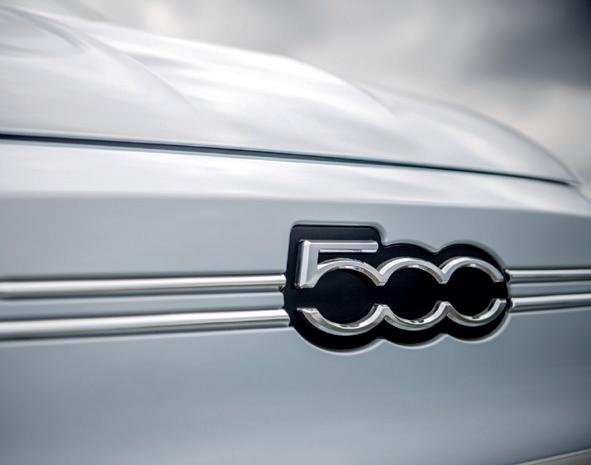


around town and those short commutes into work. Available for just over £26,000, the Fiat 500e is a relatively affordable option for anyone looking to make the switch to an electric car!

MG4 EV


The MG4 EV is one of the best electric cars we’ve had on our YouTube channel, and although it’s bigger than some of the other cars we’ve got on this list, we think it still qualifies as a small EV. Its interesting design is coupled with a great performance package, which includes a range of up

to 218 miles and a 0-60mph time of 7.7 seconds, but the best thing about the MG4 EV is the price. The MG4 starts from just over £25,000, making it considerably cheaper than its biggest competitors, and for that reason alone, it deserves to be number two on our list!



MINI ELECTRIC






Arguably the most enjoyable car to drive on this list, the Mini Electric is the definition of a pocket rocket. It might only have a small range, with around 140 miles, but that should be plenty for what this car is designed for, which is whizzing around town with a permanent smile on your face. Of course, it’s a Mini as well, so you have an iconic
design with lots of cool and quirky details dotted all around the car, too. It is slightly more expensive than the Fiat and the MG4, and its range does lose it a few points as well, but we’re putting the Mini Electric third purely on the experience of being behind the wheel of it!


 One of the newer models on this list, the NIO ET5 is a fully electric sedan from Chinese automaker, NIO. Although technically a sedan, the ET5 does feel fairly compact when up close, and having tested the
One of the newer models on this list, the NIO ET5 is a fully electric sedan from Chinese automaker, NIO. Although technically a sedan, the ET5 does feel fairly compact when up close, and having tested the
THE REVIEW HERE!
car in Gothenburg, Sweden, the ET5 is nice and comfortable even in a packed city centre. Scan this QR code to find out more about the NIO ET5!
NIO ET5 WATCH
CUPRA BORN





Practical, sporty and spacious, the Cupra Born is a great small electric car which also offers an impressive range. With prices starting from just over £36,000, it’s one of the more premium entries on this list, but


that price does offer you 235 miles of range and a performance package which boasts 204bhp and a 0-60mph time of 7.3 seconds. It might be pricey, but the Cupra Born does a great job of justifying its price tag.
BMW i3

The BMW i3 might not be the prettiest car on this list, but it is one of the most iconic. The i3 is one of the original small EVs, having first been released in 2013, and despite being ten years old, it is still a great option today for anyone looking to switch to an EV.
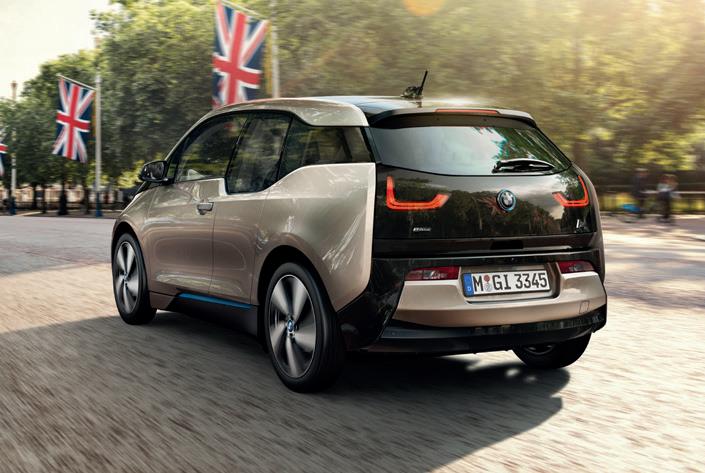
Newer models start from just under £31,000 and offer a range of up to 188 miles. It might have quite an awkward, boxy design, but the i3 can shift when it needs to, with a 0-60mph time of 6.9 seconds on the upgraded i3s model.

WATCH THE REVIEW
HERE!
HONDA E
If you’re cruising down the street in the Honda E, you’re going to be turning a few heads. The original Honda E has one of the most interesting and quirky car designs of any electric car, and the new Honda e:NY1, which is due to be released next year, builds on that iconic design. The

original Honda E makes it onto our list in the seventh spot, mainly for its cool exterior, but it is also worth mentioning its level of performance, which includes a 0-60 time of 8.3 seconds and a fully-electric range of 131 miles.
ID.3
Volkswagen’s fully electric ID.3 is arguably one of the most iconic electric vehicles of all time. Since its launch, the ID.3 has been one of the bestselling electric vehicles in the UK, and just recently, Volkswagen has






released a new, updated ID.3, which features a revamped design and improved performance. Want to know more about the new ID.3? Then head over to our double-page spread on page 21.

CORSA E
The Vauxhall Corsa E is perhaps one of the most accessible small electric cars on this list. Thanks to Vauxhall’s impressive range of financing options, you could own your very own Corsa E for as little as £233 a month.







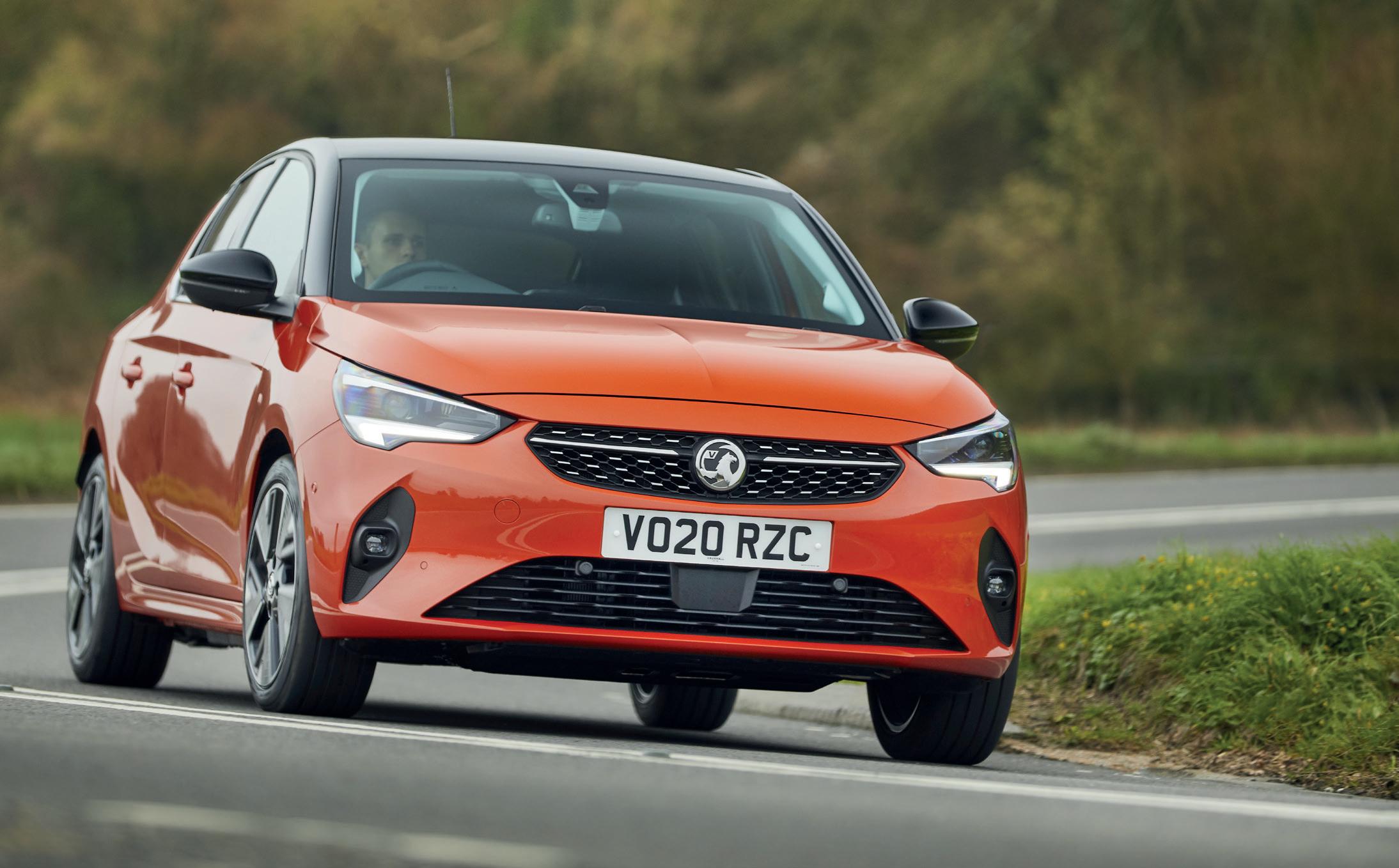
It might not be able to compete with some of the other cars on this list, but with a nice, simple design, a range of up to 220 miles and decent performance, we think the Corsa E more than deserves a spot on this list.
CITROEN AMI
We just had to include the Citroen Ami, didn’t we? Technically a quadricycle, the Ami is the true definition of a small EV. Despite its unusual design, which has had mixed reviews, the Ami is surprisingly practical, and it is also the most affordable vehicle on this list, with prices starting from £7,695. It might
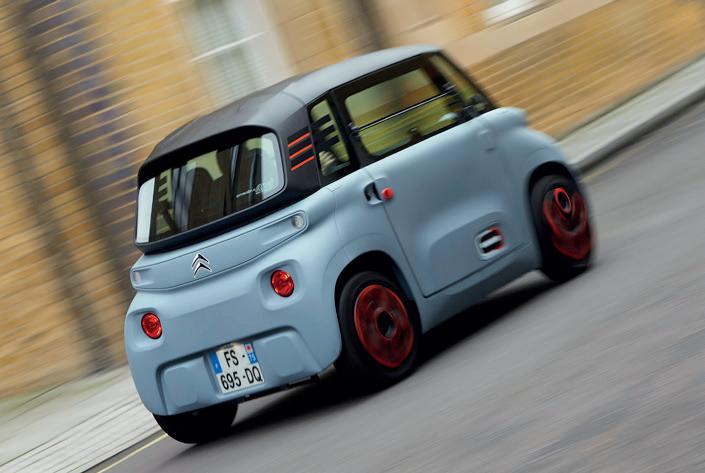

be a bit funny to look at, but the Ami is an important step forward for the electric vehicle industry. As major cities across the UK and Europe prepare to go all electric – Paris, for example, has outlined its plan to ICE vehicles from its roads from 2030 – vehicles like the Ami will be ideal choices.




EVS COULD SAVE COURIERS £5.5K PER YEAR WITH THOSE WORKING IN CLEAN AIR ZONES SAVING AND ADDITIONAL £1.5K WITH ZERO EMISSIONS!
As the Ford Fiesta has ceased a production, a new courier van has been launched that is fully electric and looks set to deliver savings to couriers of over £5,000 annually, when compared to the leading diesel alternative – the Ford Fiesta van.

Those operating in congestion charge/clean air zones, could benefit from an additional £1,500 saving in charges with the government’s 2030 deadline on the sale of new petrol and diesel cars.
The research, undertaken by EV conversion specialists, Vic Young compared the industryleading Ford Fiesta van with the new fully electric Zoe that they have created in partnership with Renault, in an aim to reduce emissions and costs for the courier and delivery industry, with a viable alternative with good range.
The first point of difference was cost, with the Renault Zoe priced at almost £4.5k cheaper than the equivalent Fiesta from the same year (2020). Vic Young then compared the average MPG of the Fiesta from recent WhatCar real world testing with the ‘real world range’ (RWR) of the Zoe at full charge (195 miles) to establish an average cost per mile would be for both. The Renault Zoe came in at 7p per mile, whereas the Fiesta was almost double at 12p per mile. Using data from the Department for Transport’s latest van and logistics figures, the average mileage for those operating for the delivery of products and goods was 21,200 per year. Based on a 47-week working year, and an assumed 5 days of working per week on average, the average daily mileage came in at just over 90 miles.
When comparing these figures, the Renault Zoe came in cheaper in every single category when compared to the diesel-emitting Fiesta, showing that not only was the Zoe nearly £10 per day cheaper to deliver, but would not exceed the ‘real world range’ of the Zoe’s battery of 195 miles. A breakdown can be seen below:
working day in, day out, ensuring that people’s orders and goods are delivered. With the popular Ford Fiesta ceasing production, we had the opportunity with Renault to use our skills in conversions to present a viable and more economical alternative as we get closer and closer to the government’s 2030 deadline on the sale petrol and diesel vehicles.”
With emissions a key target area for the Government, the data also showed that those operating within congestion charge/clean air zones would benefit further with an average saving close to £1,500 in charges that wouldn’t need to be paid for the exemption of an EV.
Vic Young, MD of Vic Young Motor Group, made the following comments: “The pressure to cut emissions within the transport sector is huge, but that is all dependent on having the right options for those
They continued: “With the fleet of Zoes we have converted so far, we’re showing that the limitations in range of EVs is reducing quickly, especially when comparing the average daily distances for delivering goods and the range of the Zoe courier van. We’re really proud of this partnership and the environmental impact and financial benefits when costs are increasing and emissions pressure mounting.”
EV RESEARCH 34
Purchase cost (2020 models) Cost per mile RENAULT ZOE £17,950.00 £0.07 Cost per day to deliver (based on AVG) CPM for Zoe’s RWR of 195 mls Annual running cost £13.65 £6.30 £1,484.00 FORD FIESTA VAN £22,397.00 £0.12 £23.40 £10.80 £2,544.00 DIFFERENCE £4,447.00 £0.05 £9.75 £4.50 £1,060.00 £5,507.00
IS MISINFORMATION PUTTING BRAKES ON THE USED EV MARKET?
According to insight from the Society of Motor Manufacturers and Traders (SMMT), more than 30,500 second-hand battery electric vehicles (BEVs) changed hands in the second quarter of 2023, an 81.8% rise on the same period last year. [1] Used plug-in hybrids (PHEVs) also grew in popularity, with sales up 11%.

In terms of availability, a quick search on Autotrader brings up more than 16,500 results for used BEVs and nearly 11,000 results for used PHEVs, spanning 47 manufacturers and hundreds of models – from hatchbacks and hybrids to coupes and convertibles. The choice is truly vast, and availability is immediate.
While you can’t miss the mix of top-end nearly new models pushing upwards of £100k, there’s also a huge choice of cars for far less than £17,920[2] – the average UK spend on a secondhand vehicle. You might have to compromise a little when it comes to colour, features or mileage, but the listings are packed with brilliant buys!
The used EV market should be thriving – and such impressive growth figures suggest that progress is building fast. However, when you dig beneath the surface, the reality is a little different. Indeed, as a percentage of total used car sales, plug-in vehicles comprise less than 2% of transactions. There seems a dichotomy between the growing opportunity and lacking consumer confidence. But why? Well, even though the choice is there, many motorists are still put off by misinformation. From
battery systems failing and range figures plummeting, to planned obsolescence after an initial three-year finance deal is up, we’ve all heard the rumours. But what’s the truth? How long can you really keep an EV? When will you need a new battery? Does the range start to drop quickly after purchase? What’s more, with energy market volatility seeing electricity prices rocket, do the risks really outweigh the benefits of EV over ICE?
Are used EVs a ticking time bomb?
In short, no. While perceived battery life is still a concern for some motorists, experts suggest that the average electric vehicle battery (EVB) can last almost 20 years, or 200,000 miles – a significantly longer lifespan than the typical internal combustion engine and far longer than today’s average length of vehicle ownership. What’s more, while battery efficiency will eventually start to drop, the average EV will lose just 2% of accessible range per year –an arguably minor decline.
It might sound obvious, but the latest models have been designed to far outperform their petrol and diesel predecessors. Significant investment has been made by manufacturers into designing ever-more capable vehicles to suit the needs of tomorrow’s drivers and it really shows. The EVs of today, which include those on our list, have excellent ranges, impressive durability and are cheap to maintain thanks to fewer moving parts.
The anti-EV movement will tell you otherwise, but electric vehicles aren’t designed to fall apart after a few years. They’re not programmed to break, to slow down, to lose efficiency or to rack up costly servicing bills. Vehicle manufacturers are pioneering the future with cars that really are here to stay.
So, while scaremongering is commonplace, switching to electric really is the sensible option for motorists. Need a nippy run-around for your trips into town? There’s countless hatchbacks that’ll suit you down to the ground. Need

something a little bigger for motorway journeys? You can pick up an SUV, saloon or estate that’ll keep on going for another decade.
But what about the elephant in the room? The volatile energy market and high electricity bills. Will your used EV quickly become a drain on your finances? Will the price cap rise far above falling petrol prices, leaving me between a rock and a hard place? All important questions but, again, motorists shouldn’t be concerned.
While the environmental benefits of EVs are widely publicised, the financial benefits are equally as impressive. At current prices, a small hatchback would cost less than £650 per annum for the average driver to run if they charge at home. Even though these prices will increase when the energy price cap changes, EVs will still be the most costefficient option by far – especially with fuel prices pushing £1.50 per litre (for diesel) and an average tank (55 litres) costing upwards of £80.
The real cheat is if you have a solar array and an eco-smart home EV charger, like the myenergi zappi. In this instance, you can effectively charge for free by self-consuming your self-generated renewable energy – zero fossil fuels, zero reliance on the grid, zero emissions travel. Of course, it requires an upfront investment, but the ability to take total control of your home energy use is an attractive one.
So, should you look to the used market for your next EV? Well absolutely – there really is something for everyone. What’s more, with a huge selection and less than average demand, you’ll likely grab a steal!
As we move ever-closer towards 2030, however, the used EV market must become a key part of the UK’s transition to electrification. The laggards and self-professed petrolheads will continue to spread misinformation, but the reality is really quite different from the current driver perception. Let’s not allow rumours to slow the transition to electrification.
35 OPINION
Jordan Brompton, co-founder and CMO of myenergi, explores the latest second-hand EV sales data and discusses whether dated views and misconceptions are holding back the transition to electrification.
Want more control of your business budgeting?


This is Jasmin. She’s one of many business owners who already use a smart meter to feel more in control of their budgeting, because smart meters help you track your energy use and costs over time.
So like Jasmin, you can spend less time guessing and instead know how much you’re spending on your energy bills.
Search ‘get a smart meter’ today.
Eligibility may vary. Consumer action required. ALBERT EINSTEIN rights licensed by the H.U.J./BEN Group, Inc.


+ The latest news and updates for everything Electric Home PUSHES BAN ON GAS BOILER INSTALLATIONS TO 2033 ?!
SUNAK
SUNAK pushes ban on GAS BOILER INSTALLATIONS to 2033
Prime Minister Rishi Sunak has promised more time for households to make the transition to heat pumps under plans to decarbonise the country’s homes.

The target was for no gas boilers to be installed in new homes by 2025, and for the phasing out of boilers altogether to begin in 2033.
Sunak told a press conference that households will only have to make the switch when they’re changing their boiler anyway, and not until 2035.
He said the government would never force anyone to replace a gas boiler with a heat pump. Instead, householders will only be required to switch when they are due to change their boiler anyway.
Heat pumps, he said, needed to be made cheaper without imposing high costs on families at a time while technology is still expensive.
The Prime Minister also pushed back the ban on the sale of new petrol and diesel cars in the UK from 2030 to 2035, aligning with EU countries like Germany, France, Spain and Italy.
Michael Cook, Group Managing Director of Leaders Romans Group, welcomed the latest u-turn and says asking landlords and homeowner to spend even more money was ‘unwanted pressure’.
He says: “Whilst we recognise all individuals and industries must think differently and act differently to reduce their carbon footprint and the impact of climate change, we welcome this u-turn by the government.
“Essentially, asking homeowners and landlords to dig deeper into their pockets at this difficult time is unwanted pressure.
“Landlords in particular have been continually hit with higher taxation and legislation, coupled with inflationary pressure and higher interest rates, leading many to conclude that its is time to sell.
“This supply restriction has seen rents go up at a greater rate than in living memory. Reducing capital outlay by reversing out of policies like this is in everyone’s interest in the short to medium turn.”
Ben Beadle, Chief Executive of the National Residential Landlords Association, says: “We want to see all properties as energy efficient as possible. However, the uncertainty surrounding energy efficiency policy has been hugely damaging to the supply of rented properties.
“Landlords are struggling to make investment decisions without a clear idea of the Government’s direction of travel.
“It is welcome that landlords will not be required to invest substantial sums of money during a cost-ofliving crisis when many are themselves struggling financially. However, ministers need to use the space they are creating to develop a full plan that supports the rental market to make the energy efficiency improvements we all want to see.
“This must include appropriate financial support and reform of the tax system which currently fails to support investment in energy efficiency measures.”

NEWS 38
ENERGY DISCOUNTS FOR CUSTOMERS WHO SUPPORT LOCAL WIND FARMS: A New Initiative to Benefit SMEs


The Wind of Change
The plan is spearheaded by Ripple Energy, a renewable energy company that is urging customers to buy a share in their local wind farm for as little as £1,900. In return, these customers will receive discounts on their energy bills for up to 25 years, providing a longterm return on their initial investment.
Ripple Energy’s approach is not only innovative but also a win-win for all parties involved. SMEs that invest in this scheme can benefit from reduced energy costs, while also playing their part in promoting renewable energy sources. The discounted energy bills could provide significant savings for businesses, especially those in energy-intensive sectors.
A Sustainable Future for SMEs
This initiative is particularly timely as the UK government has made it clear that businesses of all sizes have a role to play in the transition to a lowcarbon economy. By supporting local wind farms, SMEs can actively contribute to the UK’s goal of achieving net-zero carbon emissions by 2050. Moreover, for SMEs, participating in such initiatives could enhance their corporate social responsibility profile. Today’s consumers are increasingly conscious about the environment, and businesses that demonstrate a commitment to sustainable practices are often viewed more favourably.
Ripple Energy’s Vision
Ripple Energy’s business model is designed to make renewable energy sources more accessible to the average consumer. By creating a model where customers have a stake in the energy they use, Ripple Energy is fostering a sense of ownership and responsibility towards renewable energy generation.
This move could be a game-changer for the UK’s energy sector, revolutionising the relationship between energy providers and consumers. It presents an opportunity for SMEs to be part of this change, benefiting from discounted energy while also supporting a more sustainable future.
THE SOLAR SURGE
UK Homeowners Embracing
The UK government’s increased focus on renewable energy is paying dividends, as more and more homeowners harness the power of the sun. According to recent statistics, solar panel installations have seen a significant upswing over the past year. The government’s “Green Homes Grant” scheme has
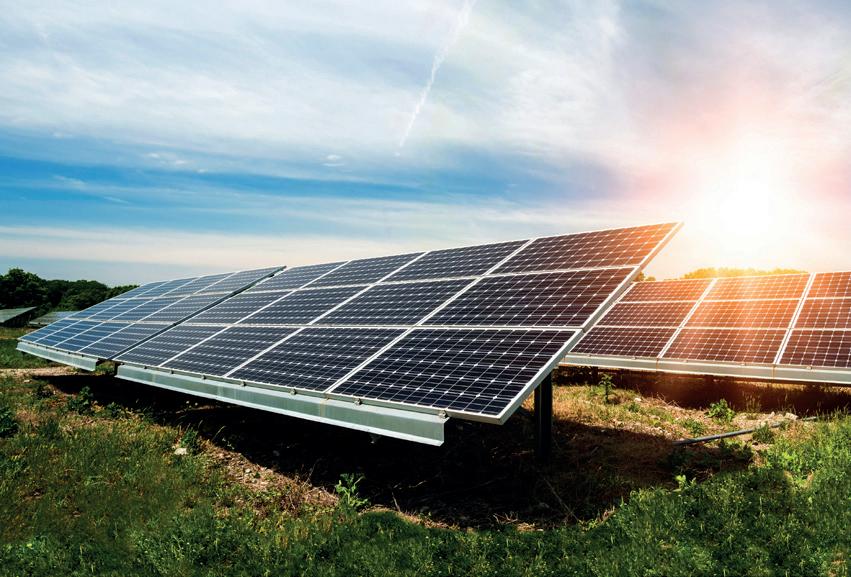
the Sun
played a significant part in this surge, offering homeowners up to £5000 to improve the energy efficiency of their homes. With solar panels reducing energy bills and boasting a payback period of less than 10 years, there’s never been a better time for homeowners to go solar.
The Road Ahead
While Ripple Energy’s initiative is promising, the success of such schemes relies on widespread adoption. It is therefore crucial for SMEs to understand the benefits of investing in renewable energy and the potential savings they could make on their energy bills.
There is also a need for further regulatory support to encourage investments in renewable energy. The UK government’s commitment to a greener future and support for innovative business models like Ripple Energy presents a promising future for renewable energy in the UK.
Ripple Energy’s initiative of offering energy discounts to customers who back local wind farms is a significant step forward in promoting renewable energy in the UK. It offers SMEs a unique opportunity to reduce their energy costs while contributing to a sustainable future. The potential benefits for SMEs are clear, from cost savings on energy bills to an enhanced reputation for sustainability. The success of this initiative could pave the way for similar schemes in the future, marking a new era for renewable energy and the role of businesses in supporting it.
For SMEs looking to balance cost-efficiency with social responsibility, this initiative could be a key component of their business strategy. It’s a chance to be part of a movement that not only promises financial benefits but also creates a sustainable future for all.
39 NEWS
In a revolutionary move set to benefit small and medium-sized enterprises (SMEs) across the UK, energy customers are now being offered discounts if they back local wind farms. This initiative, recently reported in The Times, is a promising step towards sustainable energy practices while providing financial relief for businesses.
WIND POWER A Gale of Change for UK Consumers
The winds of change are blowing through the UK, as wind power becomes an increasingly viable option for homeowners and consumers alike. The UK is the world’s sixth-largest producer of wind power, and domestic wind turbines are becoming a common sight in many rural areas. Consumers
can now invest in “wind shares”, allowing them to benefit from wind farms’ profits, while also contributing to a greener future. With the average wind turbine generating enough electricity to power 1,500 homes annually, this renewable energy source is making waves.
GEOTHERMAL ENERGY Heating Homes from the Earth’s Core
UK homeowners are digging deep to find renewable energy solutions, with geothermal energy rapidly gaining popularity. This form of energy exploits the natural heat from the Earth’s core to heat homes and generate electricity. The UK’s first geothermal plant in Cornwall has proven

HYDROELECTRIC POWER UK Consumers Making a Splash

UK consumers are diving into renewable energy with hydroelectric power. Small-scale hydroelectric systems, also known as micro-hydro, are particularly suited to the UK’s wet climate and varied topography. These systems use the flow of water to generate electricity, providing a reliable
CLAIRE COUTINHO appointed as new energy secretary
and continuous source of renewable energy. While the upfront cost can be high, the long-term savings and environmental benefits make it a compelling choice. The Energy Saving Trust estimates that a micro-hydro system could save a typical home up to £3,000 a year on electricity bills.
successful, paving the way for this renewable source’s wider adoption. The government’s Renewable Heat Incentive scheme encourages homeowners to install ground source heat pumps, offering financial incentives for those who make the switch.

UK MUST build more pylons and power lines to carry cleaner energy
Claire Coutinho has been appointed as Rishi Sunak’s new energy secretary, becoming the first of the 2019 intake of Tory MPs to take a seat around the cabinet table.

New pylons and power lines are needed to ensure the lights stay on, renewables leaders have said.
A report by Scottish Renewables, which represents companies working across the sector, said new infrastructure was required to transmit the electricity generated by green power sources and help to develop “a clean energy future”.

built in the past 30 years, at a cost of more than £50 billion”.
The Scottish Renewables report said: “Scotland is the UK’s renewable energy powerhouse. Our winds, tides, rainfall and longer daylight hours already provide tens of thousands of jobs and billions of pounds of economic activity.
The MP for Surrey East is a firm ally of Sunak. She was his first special adviser when he became chief secretary to the Treasury in 2019, and this year she co-hosted a summer gathering for Sunak loyalists and junior ministers.
During last summer’s leadership race Coutinho, 38, who has also served as Sunak’s PPS, was constantly at his side as he made the rounds of MPs. But her appointment will be about more than just loyalty. There has long been a desire in No 10 to promote more ambitious, younger women into cabinet jobs, and Coutinho fits the bill.
It comes as electricity firms looking to build new lines or pylons are facing protests by campaign groups. The Strathpeffer and Contin Better Cable Route group is challenging the power giant SSEN over the planned network of pylons that will run for about 100 miles from Spittal in Caithness to Beauly, near Inverness.
Scottish Renewables said it was time to be “upfront and honest” about the need for updated infrastructure.
It said previous work by the UK National Grid estimated “five times more transmission lines need to be built by 2030 than have been

“But we’re being held back from doing more by an electricity grid designed for fossil fuels almost a century ago.”
Investment in the transmission network has “remained flat and even decreased since 2017,” the report said.
NEWS 40
41 SMART HOME
SMART HOME: WHAT DOES IT REALLY MEAN?
According to a recent report by Statista, the number of smart home tech users will grow by an estimated 88% per annum between now and 2027 – an additional 13.9 million households. Embracing these new technologies promises to further optimise energy use, efficiency, and consumer convenience, but what does it really mean to have a smart home?
According to a recent report by Statista, the number of smart home tech users will grow by an estimated 88% per annum between now and 2027 – an additional 13.9 million households. Embracing these new technologies promises to further optimise energy use, efficiency, and consumer convenience, but what does it really mean to have a smart home?
Simply put, a smart home uses intelligent devices and systems, usually connected together via the internet, to offer varying levels of automation and control over functions such as energy, lighting, heating, security and entertainment. There are currently around 2.2 million smart homes in the UK – around 8 per cent of all properties. As the technology becomes more prevalent, it is also becoming an attractive feature for homebuyers, with 65 per cent of people saying they would pay more for a smart home.
When most people think of smart devices, they typically think of connected TVs, voice assistants and scheduled temperature control devices, but this is just the start. Consider security systems with smart locks, cameras, and alarms that provide enhanced protection and surveillance, allowing you to monitor your home from the convenience of your smartphone. Don’t forget about automated air quality monitoring, touchless sinks and indoor sensor lights either. Integrating these technologies allows homeowners to create a synchronised and responsive living environment, reflecting a blend of convenience, efficiency, safety, and sustainability.

One of the biggest advantages of connected systems is the data that they generate. After all, the information can be used to further optimise each system, perfecting how they work and interact with homeowners. With the rise of Artificial Intelligence (AI), the use of smart systems can be further simplified and automated. This can have significant benefits for things like energy use and home efficiency.
The rise of smart technologies and the integration of intelligent systems is a key area of interest for the homes of tomorrow. But is it really as simple as hanging a smart TV on the wall? We spoke to Jordan Brompton, cofounder and CMO of myenergi, to learn more.
Consider temperature control, for example. When you’re at work, the system turns off, but it knows that you arrive back at 6pm and turns on for your arrival. It is all about making the home more efficient and comfortable, tailored to the specific parameters, while also reducing household energy consumption.
But simply turning on and off energy is pretty basic. Where smart home tech gets interesting is when it comes to self-generated renewable energy.
According to data from the government’s MCS (Microgeneration Certification Scheme), there are around 1.3 million UK homes with solar panels – around 4.9% of the population. This figure is only set to increase, with 2022 seeing double the photovoltaic (PV) solar installations, year-on-year, up to an impressive 130,596. This is the highest number installed annually since the record ‘boom’ year of 2015. Self-generation, particularly through renewable sources like solar and wind, represents a shift towards sustainability and independence from traditional energy grids, empowering homeowners to create and control their own energy supply.
But to fully realise the potential of self-generation, it’s vital to have systems in place that can seamlessly integrate renewable energy into home use. This requires sophisticated technology that can adapt to fluctuating energy production, efficiently store surplus energy, and distribute it according to the household’s needs. For a home to be truly ‘smart’, it must take a sustainable and optimised approach to energy consumption.
This transformative approach to energy use is exemplified by myenergi’s suite of eco-smart

technologies. Our zappi EV charger is developed with the aim to fully utilise green energy generated from renewables. Working alongside zappi is eddi, a device designed to optimise the use of surplus solar or wind energy. Rather than sending unused energy back to the grid, eddi diverts it for heating water or rooms. What about energy storage? Our libbi is a modular battery storage system that captures and intelligently manages surplus energy based on household usage and electricity tariffs.
These systems are not only modular but also smart, meaning each can be monitored and managed via a smartphone application with real-time displays and graphs. As smart homes increase in complexity and more household switch to electric vehicles, myenergi’s innovative products offer solutions that allow users to maximise efficiency and take back control.
The future of smart homes is an exciting confluence of data, devices, optimisation, and personalisation. As technology continues to advance, we can anticipate a more seamless and intuitive experience in managing home environments and the energy we use.
Undoubtedly, AI and machine learning will play an ever-greater role in enabling homes to adapt and respond to user behaviour. Of course, sustainability will continue to be a central theme, with increasing government legislation and industry innovation driving change in our homes. The ongoing evolution of smart home technologies promises to redefine our relationship with our living spaces, optimising them for us and the planet.
Best Air Source Heat Pumps for Residential Homes in the UK


As the UK transitions to a more sustainable future, air source heat pumps (ASHPs) are becoming increasingly popular in residential homes. These innovative devices transfer heat from the air outside to inside your home, providing an energy-efficient way to heat your home and water. But, with so many options on the market, which one should you choose? We’ve done the hard work for you and compiled a comprehensive list of the best air source heat pumps available in the UK right now.
Daikin Altherma 3 Mitsubishi Ecodan
The Daikin Altherma 3 is a premium-tier ASHP, renowned for its high energy efficiency and advanced technology. Its features include a user-friendly interface, quiet operation, and a wide temperature range, making it a versatile choice for UK homes. It also has low maintenance requirements, and installation is straightforward if handled by a professional.
The Mitsubishi Ecodan is another top-rated ASHP, known for its performance and durability. It offers excellent seasonal efficiency and uses advanced technology to minimise energy consumption. The Ecodan is also designed for easy installation and maintenance, making it a user-friendly choice.
Pros Cons Pros Cons
• High energy efficiency
• Advanced technology
• User-friendly interface
• Premium price
• Requires professional installation
• Excellent seasonal efficiency
• Durable and reliable
• Easy installation and maintenance
• Higher initial cost
• Might not suit smaller properties
AIR SOURCE HEAT PUMPS 42
AIR SOURCE HEAT PUMPS


LG Therma V Nibe F2040
The LG Therma V stands out for its innovative features and high energy efficiency. It uses advanced inverter technology for efficient heat exchange and has a smart control system for ease of use. While it may require more regular maintenance, its performance and features make it a worthy contender.
The Nibe F2040 is designed for simplicity and efficiency. It has a compact design, making it suitable for smaller homes, and offers impressive performance, even in harsh weather conditions. While installation may be more complex due to its unique design, its efficiency and performance make it a great choice.
Pros Cons Pros Cons
• High energy efficiency
• Innovative features
• Smart control system
• Requires regular maintenance
• High initial cost
• Compact design
• Impressive performance
• Suitable for smaller homes
Why Choose Air Source Heat Pumps?
ASHPs are an excellent choice for UK homeowners looking to reduce their carbon footprint and save on energy bills. They are more energy-efficient than traditional heating systems, as they transfer heat rather than generate it. ASHPs also have lower maintenance requirements and longer life spans than traditional heating systems. Despite the higher initial cost, the long-term
• More complex installation
• Lower capacity than other models
savings and environmental benefits make them a worthy investment.
Remember, the best ASHP for you depends on your home’s size, your budget, and your heating needs. Always consult a professional before making a decision. We hope this review helps you make an informed choice on the best air source heat pump for your home.
43
CARBON CAPTURE IN THE UK: A GREEN SOLUTION?

As we grapple with the escalating climate crisis, innovative solutions such as carbon capture and storage (CCS) are emerging as significant game-changers. This in-depth analysis examines the intricacies of carbon capture, its benefits and challenges, and the UK companies leading the charge in this green revolution.
CARBON CAPTURE: THE BASICS
At its core, carbon capture is a process designed to help combat global warming by capturing carbon dioxide (CO2) emissions produced by industries and storing it underground or using it commercially. It involves three key steps: capture, transport, and storage or use.
The capture involves separating CO2 from other gases produced by industrial processes. Transport entails moving the captured CO2, usually via pipelines, to a storage site. The storage or use phase involves injecting the CO2 deep underground into geological formations or using it in other commercial applications such as enhanced oil recovery or the production of building materials.
THE PROMISE OF CARBON CAPTURE
The main benefit of CCS is its potential to significantly reduce CO2 emissions, a leading cause of global warming. By capturing and storing CO2, we can continue to use fossil fuels while minimising their environmental impact. Additionally, the technology could be crucial in achieving net-zero emissions targets, as it not only reduces emissions but can also remove CO2 from the atmosphere when coupled with biomass energy production.
THE CHALLENGES AHEAD
However, carbon capture is not without its challenges. The technology is complex and costly. The infrastructure required for large-scale implementation is extensive, and the long-term effects of storing CO2 underground are not fully understood.
Moreover, the commercial viability of CCS is a concern. Without adequate market incentives or regulatory support, companies may be reluctant to invest in this technology. Additionally, public acceptance can be a hurdle, as people might have concerns about the safety and environmental impact of storing CO2 underground.
THE UK’S CARBON CAPTURE PIONEERS
Despite these challenges, several UK companies are already making strides in CCS. Here are a few key players:
Known for operating the largest power station in the UK, Drax has ambitious plans for carbon capture. They are developing bioenergy with carbon capture and storage (BECCS) technology, aiming to capture 8 million tonnes of CO2 annually by 2030.

SWITCH 44
1. DRAX GROUP:
45 HYDROGEN
2. BP:
BP, in partnership with Eni, Equinor, National Grid, Shell, and Total, is part of the Northern Endurance Partnership, a project aiming to capture and store 20 million tonnes of CO2 annually by 2030 in the North Sea.

3. SSE THERMAL:
This energy company, in collaboration with Equinor, is developing two low-carbon power stations equipped with carbon capture technology in the Humber and Teesside regions.
4. STOREGGA, SHELL, AND HARBOUR ENERGY:
These companies are working on the Acorn Project in Scotland, which aims to capture CO2 from the St Fergus Gas Terminal and store it beneath the North Sea.
LOOKING FORWARD
While the UK is emerging as a leader in CCS, the journey is just beginning. Government support and regulatory frameworks will be crucial in encouraging more companies to invest in carbon capture. Moreover, research and development will play a vital role in enhancing the efficiency and cost-effectiveness of CCS technology. A collaborative effort involving policy-makers, researchers, and businesses is needed to realise the full potential of carbon capture in mitigating climate change.
As we continue to navigate the complexities of the climate crisis, carbon capture presents a promising, albeit challenging, path forward. Only time will tell if this technology can deliver on its promise and help us transition to a more sustainable future.

ONLY TIME WILL TELL IF THIS TECHNOLOGY CAN DELIVER ON ITS PROMISE AND HELP US TRANSITION TO A MORE SUSTAINABLE FUTURE.
Turning Over Your Guide to a New Leaf: Sustainable Autumn Fashion

Autumn is a picturesque season of transformation, a time when nature dons a fiery palette, and the air turns crisp and cool. Just as the leaves turn, it’s time we turn too - towards sustainable fashion.
In this edition of Turning Electric, we aim to guide you through an array of environmentally-friendly clothing options for your autumn wardrobe.

AUTUMN FASHION 46
Fashion: The Unseen Environmental Culprit
Often, when we think of environmental pollution, images of smoke-spewing factories and plastic-filled oceans come to mind. But one of the lesser-known culprits is the fashion industry. It’s the second-largest consumer of the world’s water supply and emits 10% of all carbon emissions.
The Transformation Towards Sustainable Fashion

Sustainable fashion is not just a trend; it’s a movement towards reducing this environmental impact while ensuring ethical practices in clothing production. It embraces eco-friendly fabrics, energy-efficient production methods, fair trade, and ethical labor practices.
Sustainable Styles for Autumn
Autumn fashion calls for cozy knits, warm hues, and comfy layers. Here are some ecofriendly brands that offer just that, without compromising on style.


Patagonia
An industry leader in sustainable fashion, Patagonia’s commitment to the environment is unrivaled. Their cozy Better Sweater, made from recycled polyester, is a perfect addition to your autumn wardrobe.
Eileen Fisher
Eileen Fisher’s timeless pieces are designed with sustainability in mind. Their organic cotton tunics and recycled cashmere sweaters are perfect for the colder months.
People Tree
People Tree is a pioneer in sustainable Fair Trade fashion. Their autumn collection features comfortable organic cotton dresses and jumpers, perfect for layering.
Kotn
Kotn’s ethically sourced Egyptian cotton basics are a musthave. Their cozy knitwear and comfy sweatpants are ideal for the autumn chill.
Everlane
Everlane is transparent about its production process, ensuring fair wages and ethical practices. Their ReNew collection, made from recycled plastic bottles, offers stylish outerwear for autumn.
The Importance of Conscious Choices

Sustainable fashion is more than just a trend. It’s about making conscious decisions about the clothes we wear and the impact they have on the environment and the people who make them. It’s about turning over a new leaf, aligning our fashion choices with our values.
As the autumn leaves fall, let it remind us of the cycle of renewal and change, and let’s embrace that change in our wardrobes too. Let’s turn electric, not just in our choice of cars but also in our choice of clothes. Remember, every sustainable choice we make contributes to a greener and more ethical world. After all, fashion is not just about looking good; it’s also about doing good.
47 AUTUMN FASHION
WINTER IS COMING SMALL STEPS TO BIG ENERGY SAVINGS FOR UK HOMEOWNERS


As the UK enters the cooler months of autumn and winter, homeowners across the country are turning up their thermostats. While it’s vital to keep our homes warm and comfortable, it’s equally crucial to do so in an energy-efficient way. Not only can this help to significantly reduce utility bills, but it also promotes sustainability and reduces our carbon footprint.

ENERGY CONSERVATION: WHY IT MATTERS
Before we delve into tips and tricks, it’s important to understand why energy conservation is key. Energy efficiency is more than just a buzzword; it’s a commitment to reducing our reliance on fossil fuels, decreasing pollution, and promoting a sustainable future. Every kilowatt saved equals less carbon dioxide released into the atmosphere.
ENERGY SAVINGS 46
PRACTICAL TIPS TO REDUCE ENERGY USAGE
Let’s explore some practical, actionable steps that UK homeowners can take to conserve energy and lower their bills as we move into autumn and winter.

USE ENERGY-EFFICIENT LIGHT BULBS
Switching to LED or other energy-efficient bulbs can significantly reduce the energy used by your home’s lighting. They last longer and can save up to £35 per bulb over its lifetime.
INVEST IN A SMART THERMOSTAT
Smart thermostats are a great investment for energy-conscious homeowners. They allow you to schedule your heating and cooling, so you’re not wasting energy when you’re not home. Some models can even learn your habits and adjust accordingly.
INSULATE YOUR HOME

A well-insulated home retains heat more effectively, reducing the need for excessive heating. Consider insulating your loft, cavity walls, and floors to keep the warmth in and the cold out.

USE DRAFT EXCLUDERS
Draft excluders are a simple, low-cost solution for preventing heat loss through doors and windows. They are easy to install and can make a noticeable difference in your home’s temperature and energy usage.
STAY ON TOP OF BOILER MAINTENANCE
Regularly servicing your boiler ensures it operates efficiently, using less energy and reducing the likelihood of expensive repairs down the line. Aim for an annual service to keep everything running smoothly.
REPLACE OLD APPLIANCES
If your appliances are more than a decade old, consider replacing them with energyefficient models. Look for appliances with the Energy Star label, indicating they meet energy efficiency standards.
WASH CLOTHES AT LOWER TEMPERATURES
A simple switch from washing your clothes at 40 degrees instead of 60 can save a significant amount of energy. Also, always ensure you’re washing a full load to maximise efficiency. While these tips might seem small, when added up, they can make a substantial difference to your energy consumption and bills. As we enter the colder months, now is the perfect time to start implementing these changes. Not only will you be saving money, but you’ll also be contributing to a more sustainable future. Energy efficiency is not just a personal benefit, but a global responsibility. After all, every little helps when it comes to conserving the world’s precious resources.
47 ENERGY SAVINGS
TURNING GREEN: THE CURRENT STATE AND FUTURE PROSPECTS OF RENEWABLE ENERGY IN THE UK
The renewable energy sector in the UK has been experiencing a sustained surge, with recent developments triggering a seismic shift towards a greener economy. As of September 2023, the UK’s renewable energy landscape is buzzing with innovative technologies, ambitious projects, and impactful policies.

According to the Department of Business, Energy & Industrial Strategy (BEIS), renewable energy sources accounted for 47.6% of the UK’s electricity generation in the second quarter of 2023. This is an impressive leap from the previous year, marking a significant stride towards the country’s goal of achieving Net Zero by 2050.
The rise of wind energy is a notable trend. Offshore wind farms have become the country’s renewable energy powerhouse, with projects like Dogger Bank - the world’s largest offshore wind farm - leading the way. This trend is driven by advancements in turbine technology and the government’s commitment to quadruple offshore wind capacity by 2030.

Solar power is also making notable strides. The UK’s solar capacity reached 13.5 GW in 2023, a 5% increase from the previous year. Innovations such as perovskite solar cells and solar windows demonstrate the sector’s potential to diversify and expand.
Moreover, the UK’s energy storage sector is witnessing a boom, with battery storage systems playing a crucial role in balancing the grid and making renewable energy more reliable. The launch
of the world’s largest liquid air battery in Manchester in 2023 is a testament to the sector’s growth. These developments are having a significant impact on the UK’s economy and businesses. Renewable energy is becoming a significant job creator, with over 400,000 people employed in the sector as of 2023. The growth of the renewable industry also means a surge in demand for various services, from engineering and construction to legal and financial services.
Moreover, businesses are increasingly recognising the benefits of transitioning to renewable energy. Not only does it help companies reduce their carbon footprint, but it also leads to cost savings in the long run. The falling costs of renewable technologies, coupled with government incentives, make the switch more appealing.
However, despite these positive trends, challenges remain. Grid infrastructure needs significant upgrades to accommodate the surge in renewable energy. Additionally, policy consistency and clarity are crucial to maintain investor confidence and drive further growth.
The UK’s renewable energy sector is at a pivotal point. The advancements and trends observed in 2023 showcase the sector’s potential to drive the country towards a sustainable, green economy. As businesses and the government continue to prioritise green energy, the future of the UK’s energy landscape looks bright and renewable.

The UK’s renewable energy sector is at a pivotal point. The advancements and trends observed in 2023 showcase the sector’s potential to drive the country towards a sustainable, green economy. ” TURNING GREEN 50
“
UK BUSINESS,

Brazil, Australia and Malaysia are among the most exciting markets for UK companies to sell to.


Learn about international opportunities for your sector at great.gov.uk/markets



Made in the UK
Sold to the World




COMING SOON & Powered by







































































































 One of the newer models on this list, the NIO ET5 is a fully electric sedan from Chinese automaker, NIO. Although technically a sedan, the ET5 does feel fairly compact when up close, and having tested the
One of the newer models on this list, the NIO ET5 is a fully electric sedan from Chinese automaker, NIO. Although technically a sedan, the ET5 does feel fairly compact when up close, and having tested the































































